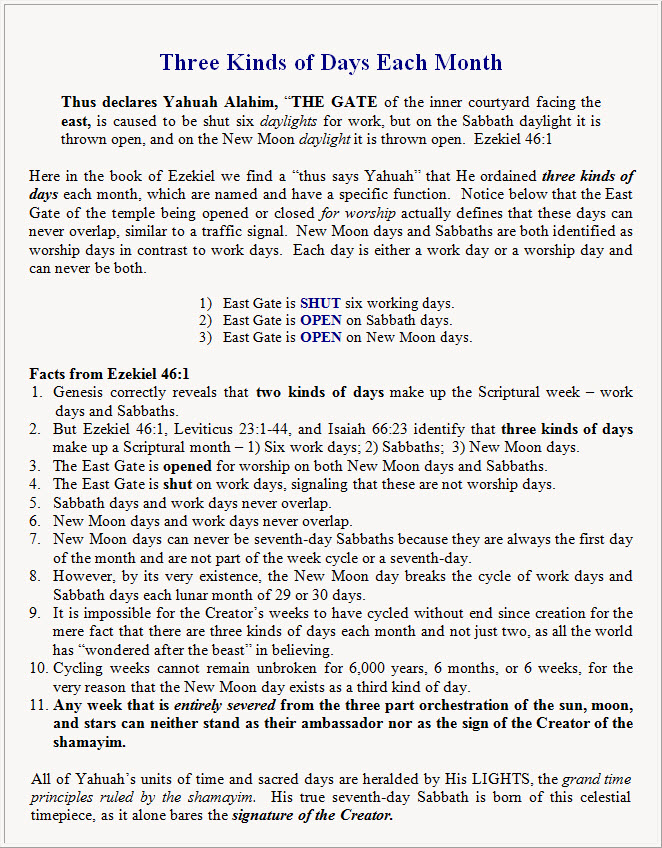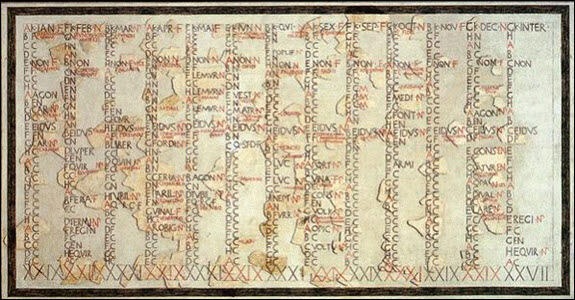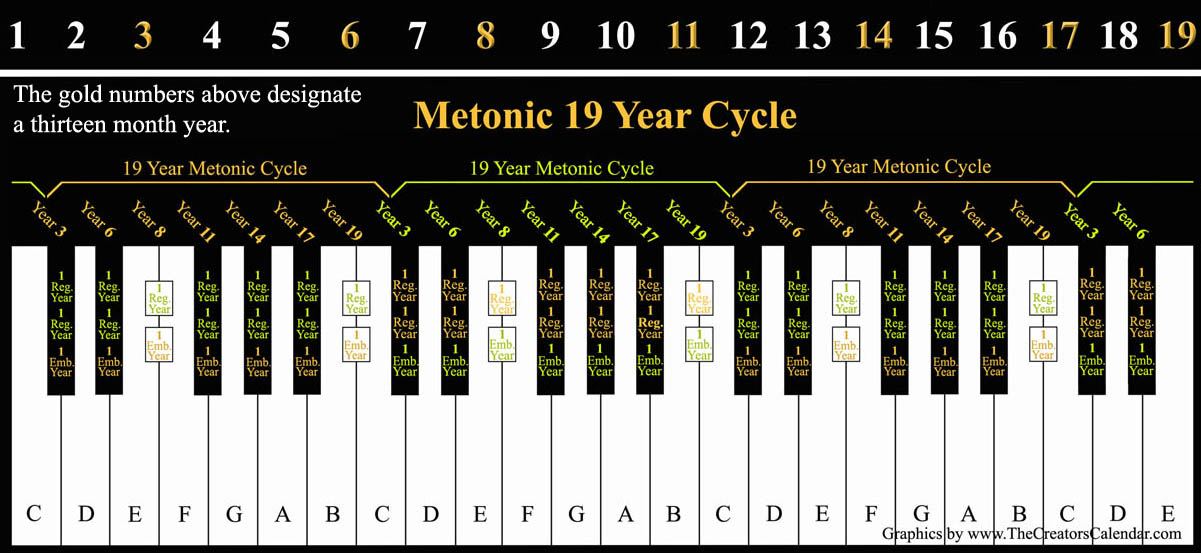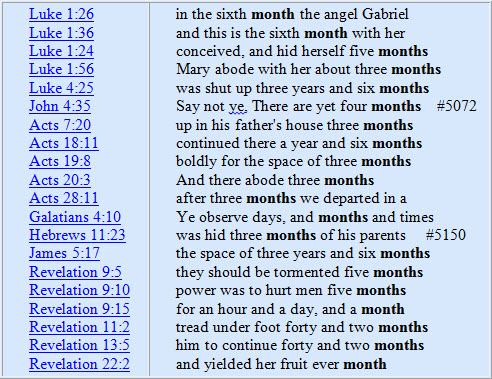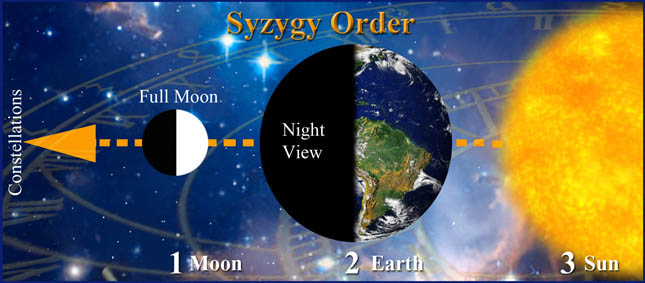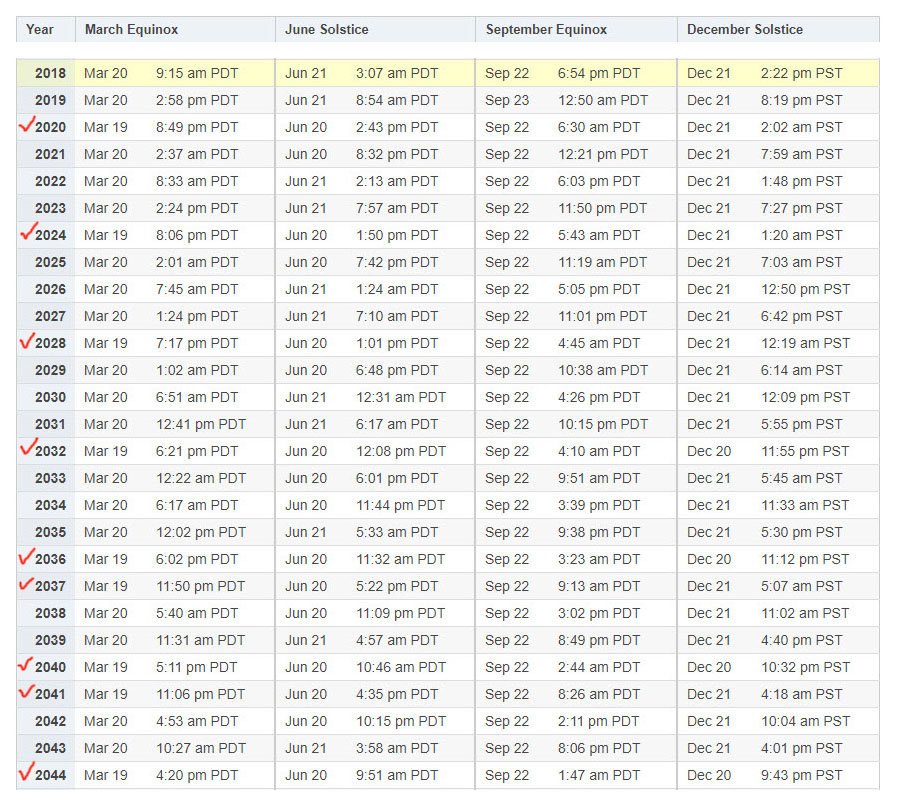Fast Facts – Word Definitions
A B C D E F G H I J K L M
N O P Q R S T U V W X Y Z
A
Ab – This is a Babylonian name given for the fifth lunar month of the astro-luni-solar calendar. It is not recorded in Scripture, nor is any other title given for this month other than it being called the Fifth Month (Numbers 33:38; Ezra 7:8; Ezekiel 20:1).
Abib/Aviv – This is one of two names recorded in Scripture for the first lunar month of the astro-luni-solar calendar year, the other if the Babylonian name Nisan. The lunar month of Abib commences as a one-night event each spring, marked by the “full” New Moon arising beneath Virgo’s feet, and shining from east to west the whole night through (Revelation 12:1). The first full daylight of this month commencing at sunrise is the Scriptural New Year’s day (Exodus 12:1-2). The Barley became ripe for the Wave Sheaf Offering on the 16th of Abib. Article Link: A Great Sign Appeared in the Shamayim (Revelation 12:1)
Adar – This is the only name recorded in Scripture for the twelfth month of the astro-luni-solar calendar, but it is attributed to Babylonian influence. It occupies the last month of winter (Joshua 15:3; Ezra 6:15; Esther 9:1).
Antikythera Mechanism – This is a 2000-year-old Grecian machine that has been called the world’s first computer. It was discovered 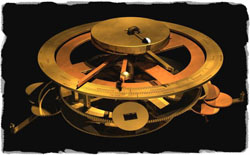 in a shipwreck near Greece and is said to have been created around 80-100 B.C. It was designed to predict the movements of the celestial bodies as well as the Olympic Games. It is said to be so accurate that it can predict both lunar and solar eclipses hundreds of years in advance.
in a shipwreck near Greece and is said to have been created around 80-100 B.C. It was designed to predict the movements of the celestial bodies as well as the Olympic Games. It is said to be so accurate that it can predict both lunar and solar eclipses hundreds of years in advance.
There are two equally exciting things about this accurate timepiece. First, and foremost, it is based upon astro-luni-solar time, in perfect harmony with the Scriptures. Secondly, it was designed to begin each month on the full New Moon in contrast to the occulted or crescent moon.
Article Link: 2000-year-old Lunar Solar Computer
Video Links: Five videos can be viewed at this link below.
Apogee – “In astronomy, that point in the orbit of any celestial body at its greatest distance from the earth: especially applied to the moon: opposed to perigee” (Webster’s New Universal Unabridged Dictionary). When the moon is in apogee, it appears slimmer/narrower and smaller. Apogee is the opposite of Perigee. See Perigee.
Appointed time – Comes from the Hebrew word “mo’edim.” These are divinely ordained worship time designations for specific events that were to occur annually or weekly as rehearsals of prophetic events of the Messiah. These include the sacred feasts days and Seventh-day Sabbath as defined in Scripture. All appointed times were in sync with the astro-luni-solar calendation as set forth by the wilderness sanctuary model, which was wholly patterned after the shamayim. The crucifixion of the Messiah marked the beginning of the Sanctuary system above, which is defined for us by the seven annual appointed feasts. It is only by synchronizing our worship rhythm to that of the shamayim that we can truly follow the Lamb whithersoever He goes from ministry to ministry within the temple mechanism above until the work of restoring mankind is complete.
Strong’s Dictionary Definition: Moed` – an appointment; a fixed time or season; a festival; an assembly convened for a definite purpose; a signal appointed beforehand.
Armageddon – is specifically stated to be the final conflict on earth at the end of time. Scripture foretells in Rev 16:16 that prior to Yahusha’s second coming there will be a rendezvous with Armageddon.
Strong’s Concordance:
Armageddon – #717 = Harmageddon (har-mag-ed-dohn’); of Hebrew origin [OT:2022 and OT:4023]; Armageddon (or Har-Meggiddon).Breaking this down—
har – #2022 = mountain (literal or figurative) and;
megiddow – (meg-id-do’) #4023 = rendezvous; Megiddon or Megiddo, a place in Palestine.
Strong’s demonstrates that “Armageddon” is a word of Hebrew origin, which is actually two words: “har” #2022, meaning mountain and “megiddo” #4023, meaning rendezvous.
Webster’s Dictionary Definition: rendezvous – 1a: a place appointed for assembling or meeting 2: a meeting at an appointed place and time.
So the definition for Armageddon is mountain rendezvous or mountain appointment, which is a meeting or assembly at an appointed place and time. Since it is Yahuah who calls the assembly together and also appoints the place and time, then the mountain referred to must have something to do with Him. It is possible that this rendezvous will be a defining point, a moment of decision between two powers; Yahuah and “His mountain of time” and “Satan with his mountain of counterfeit units of time.” Neither of these mountains are formed of dirt, rocks, and trees, but rather are symbolic mountains of time units for the express purpose of worship. The short distance between these two opposing mountain systems appears to be each person’s valley of decision, otherwise known as “the valley of the shadow of death.”
Atonement, Feast Day of – Refer to the article, Restored Prophetic Feast Days of Yahusha the Messiah.
B
Barley Harvest Law – This is a long-held tradition, not taught in Scripture, which is believed by many. It is taught that the barley harvest is the primary distinguishing factor for when the crescent or dark New Moon of the New Year was to begin. It enabled the shorter lunar year to be reconciled to the longer solar year. Coupled with this teaching, it is believed that the “full moon” (middle of the month) of the New Year would fall between April 8 and May 6. The requirement for the spring Feast of Wave Sheaf necessitated the barley to be ripe on the 16th of the first month.
Contrary to the above teaching, Scripture teaches that it is the orchestration of the sun, moon, and stars that define all of the Creator’s appointed times and seasons. New light on Revelation 12:1 illustrates that the true beacon for New Year’s Day is the “full moon” as New Moon and not the first visible crescent or dark conjunction lunar phases. It is this conspicuous beacon in the night sky that also allows the barley to be ripe for the Wave Sheaf. Article Link: A Great Sign Appeared in the Shamayim (Revelation 12:1)
Beast (of Daniel & Revelation) – He shall insult the Most High, he shall torment/wear out the righteous ones of the Most High, and he shall attempt to change the calendar and the ordinance. Daniel 7:25 (Twentieth Century Knox translation.)
Berak – The Hebrew term for blessing. Berakah is the plural form of blessings.
Bul – This is the only name recorded in Scripture for the eighth lunar month of the astro-luni-solar calendar, yet it was inherited from Babylon (1 Kings 6:38).
C
C.L.I.D. – Creator’s Lunar International Dateline. Just as the sun is utilized in harmony with an imaginary International Dateline (IDL) in the Pacific Ocean, so too the sighting of the full New Moon marks the CLID. Whether in the northern or southern hemisphere, the full New Moon will be seen and sets an imaginary line from pole to pole.
This allows the entire world to be in harmony with the definitive lunar phases, with one phase followed by the next. In this way, the earth revolves only once for each lunar phase, from the rising of the full New Moon through to the next full New Moon phase. The entire world will experience the full New Moon during a single revolution of the earth, allowing commerce and trade to take place across borders, followed the next morning at sunrise with the celebration of New Moon Day. See the illustration below.
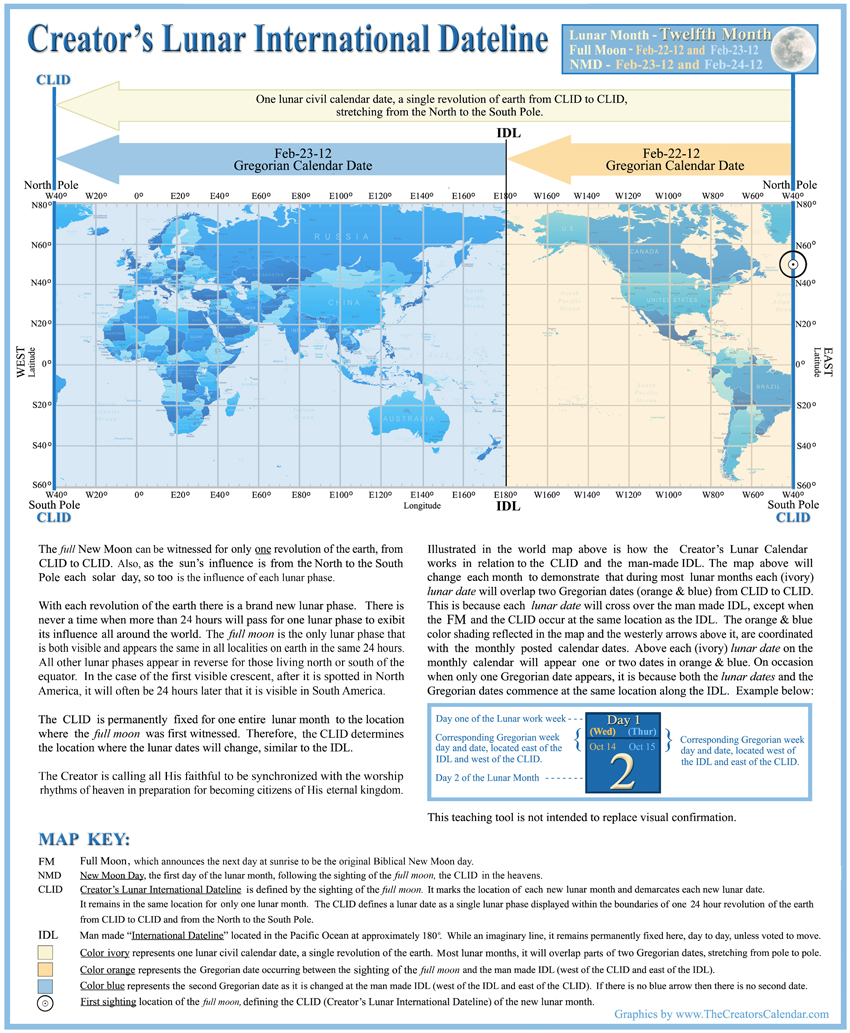 Illustrated above, it is shown that two Gregorian dates bisect most lunar dates as the sun crosses the man-made IDL. In addition to lunar dates being bisected by two Gregorian dates, the same applies to the Creator’s astro-luni-solar years and lunar months.
Illustrated above, it is shown that two Gregorian dates bisect most lunar dates as the sun crosses the man-made IDL. In addition to lunar dates being bisected by two Gregorian dates, the same applies to the Creator’s astro-luni-solar years and lunar months.
The full New Moon sets the dateline for an entire lunar month, from one New Moon to another (Isaiah 66:23). The weeks and Sabbaths fall within the parameters of the New Moons.
Calendar Date – Refer to Civil Calendar Date
Calendation – Study of calendar construction, principles or history of measuring time.
Celestial – 1. Of or pertaining to the sky or material heavens. 1597 Hooker Eccl. Pol. v. ixix. Years, days, hours, and minutes . . . all grow from celestial motion. 2. Of or pertaining to heaven, as the abode of God, the angels . . . Oxford English Dictionary, 1971 Edition.
According to Genesis 1:14, all the units of time as given by the Creator are defined by the harmonious orchestration of the sun, moon, and stars. Signs, seasons, days, and years include the week with its Sabbath for a sign, seasons refer to months defined by the New Moon lunar phase.
Chisleu – This is the only name recorded in Scripture for the ninth lunar month of the astro-luni-solar calendar. This name originates in Babylon (Nehemiah 1:1; Zechariah 7:1).
Chodesh (Kodesh) – H2320 חדשׁ. Rampant among the religious scholars is a need to remove either the “new moon” from the word Chodesh or the entire concept of it being a “lunar month.” But there is no getting around that the month in question and referenced by both Strong’s Concordance and Brown-Driver-Brigg’s, is a “lunar month.” By divine design, lunar months are made up of 29-30 lunar phases. The New Moon is the first lunar phase, which announces that the new lunar month will commence the following morning at sunrise. The New Moon cannot be separated from the lunar month any more than the head can be separated from the body and still declare them a living being.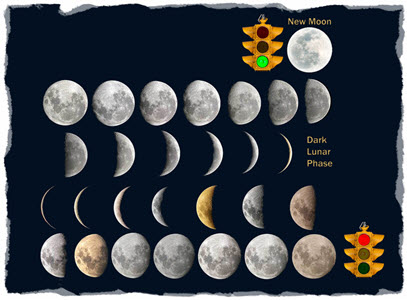
Strong’s Bible Dictionary – (chodesh #2320) the New Moon; by implication, a month: -month, monthly, new moon. From root word – chadash #2318 to be new; causatively, to rebuild [rebuilt]: renew, [renewed], repair, [repaired].
Brown-Driver-Brigg’s Hebrew Lexicon states for (chodesh #2320) – the new moon, month, monthly. a) the first day of the month; b)the lunar month.
Circumcision – Genesis 17:11 specifies that the rite of circumcision was to be performed on the eighth day. From a Hebrew word-for-word study, it is discovered that the text is not referring to the eighth day of an infant’s life. Also, circumcision was performed on occasion on adult men. As a result, the 8th day could not be consistently referring to the 8th day from birth. Neither is this 8th day in reference to the 8th day of the lunar month. Rather, this “eighth day” is specifically in reference to the day immediately following the seven-day Feast of Tabernacles. This specific seventh-day Sabbath is referred to as the “eighth-day,” as it follows the seven-day feast, although its lunar calendar date was the 22nd, counting from New Moon day. It is this day that our Savior refers to while speaking to the Priests regarding their performing circumcision on the eighth day (the seventh-day Sabbath), the day following the seven-day Feast of Tabernacles (John 9:6-14). Refer to the article, Sabbath’s Consistent Monthly Dates.
Civil Calendar Date – Synchronized to a 12-hour “day,” the 24-hour civil calendar date also begins with sunrise. Thus, from sunrise to sunrise, the day precedes the night in this hour day/night cycle.
As illustrated below, the moon and stars visibly rule together by night, announcing the new day to begin the following sunrise, but according to the demarcation of each of the 29-30 lunar phases, the dates for the lunar month. The Creator ordained the moon to properly sequence and order His division of days and dates. Nothing else in the shamayim was equipped to do so. Refer to the article, Sunrise or Sunset, When Does a Day Begin.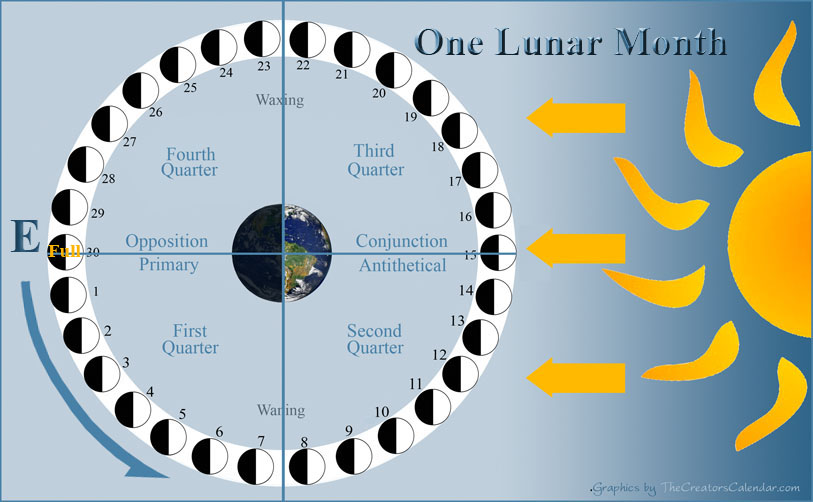
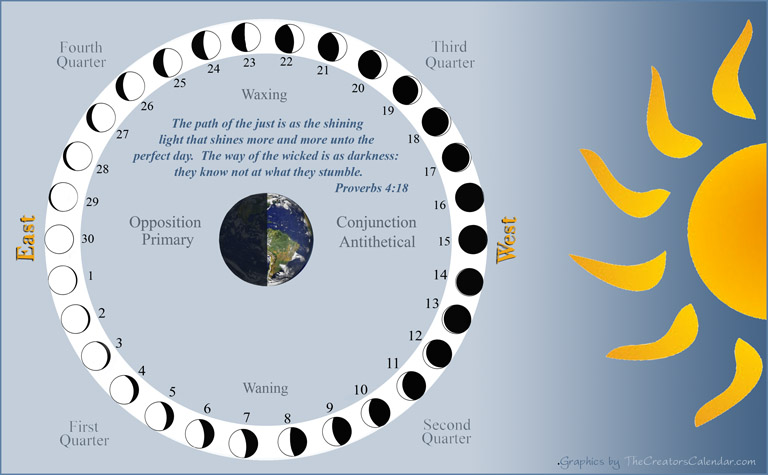
Common Years – A astro-luni-solar year in the Hebrew calendar that consisted of 12 lunations is called a common or regular year, as opposed to the 13 lunations of the embolismic years.
Conjunction – “Celestial bodies are said to be in conjunction when they are seen in the same part of the shamayim (heavens), or have the same longitude. The inferior conjunction of a planet is its position when in conjunction on the same side of the sun with the earth; the superior conjunction is its position when on the side of the sun most distant from the earth” (ibid.). When the sun, moon, and earth are in conjunction, the moon cannot be seen because it comes between the earth and the sun. This is also called the black, occulted, or invisible lunar phase.
Constantine, Emperor – (Roman Emperor Constantine ruled from A.D. 306-337). He did more to change the calendar than had been previously recognized. He had his hand in setting up Sunday as the supreme sacred day each week, but only after establishing the Babylonian seven-day week that cycled without end. There is evidence of pressure placed upon the Jews to change not only their lunar Sabbath but also the true Creator-ordained New Moon from the “full moon” to the first visible crescent. Thus causing the Jews to be out of harmony with every Scriptural unit of time.
day each week, but only after establishing the Babylonian seven-day week that cycled without end. There is evidence of pressure placed upon the Jews to change not only their lunar Sabbath but also the true Creator-ordained New Moon from the “full moon” to the first visible crescent. Thus causing the Jews to be out of harmony with every Scriptural unit of time.
The modern seven-day week came into use during the early imperial period, after the Julian calendar came into effect, apparently stimulated by immigration from the Roman East. For a while it coexisted alongside the old 8-day nundinal cycle, and fasti are known which show both cycles. It was finally given official status by Constantine in 321. Roman Calendar Encyclopedia, Days of the Week.
A Profession Of Faith From The Church Of Constantinople in the year 325 C.E.(A.D.) Under Emperor Constantine:
I renounce all customs, rites, legalisms. unleavened breads & sacrifices of lambs of the Hebrews, and all other feasts of the Hebrews, sacrifices, prayers, aspersions, purifications, sanctifications and propitiations and fasts, and new moons, and Sabbaths, and superstitions, and hymns and chants and observances and Synagogues, and the food and drink of the Hebrews; in one word, I renounce everything Jewish, every law, rite and custom and if afterwards I shall wish to deny and return to Jewish superstition, or shall be found eating with The Jews, or feasting with them, or secretly conversing and condemning the Christian religion instead of openly confuting them and condemning their vain faith, then let the trembling of Gehazi cleave to me, as well as the legal punishments to which I acknowledge myself liable. And may I be anathema in the world to come, and may my soul be set down with Satan and the devils. Source: Parks, James The Conflict Of The Church And The Synagogue Athenaeum, New York, 1974, p. 397-398.
Crescent Moon – Meant simply growing, waxing; Columella was the lunar crescent, the waxing moon; Luna decrescent, the waning moon. Oxford English Dictionary, 1971
The Crescent lunar phase is the first visible light that can be seen on the moon following the dark conjunction that occurs on the 14th or 15th of the lunar month.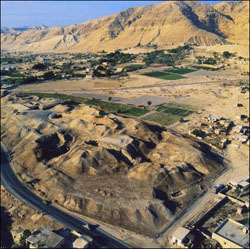
Jericho (Ya rach oh #3405) means “moon” (ya rach #3394). It was the heathen city of the Babylonian Crescent Moon-god “Sin,” which sat at the gate of Israel’s entrance to the Promised Land. Yahuah commanded Joshua to march 13 times in a “full circle” around this “crescent city” to reclaim it for Himself and His people. As the story is written, Israel marched once each night, during the fourth watch, for six nights, and on the seventh night, they marched seven times and shouted and blew their trumpets. The blowing of the trumpets was the sign to call all of the hosts of the shamayim to win this battle for them (Numbers 10:9). It was only a 15-minute walk around Jericho. The image at the right depicts the broken-down ruins of ancient Jericho.
 This image at the left is a modern monument set up in honor of Jericho. Placed on the very top of the monument is a crescent moon, and the inscription on the sign states, “Jericho, City of the Moon.” This is self-evident that it was the “crescent” that was worshiped and deemed the true New Moon to start each month by its pagan inhabitants. For this reason, Yahuah had to destroy the city.
This image at the left is a modern monument set up in honor of Jericho. Placed on the very top of the monument is a crescent moon, and the inscription on the sign states, “Jericho, City of the Moon.” This is self-evident that it was the “crescent” that was worshiped and deemed the true New Moon to start each month by its pagan inhabitants. For this reason, Yahuah had to destroy the city.
Forty years previous, Israel has been miraculously rescued from the clutches of the Egyptians, who reckoned all time and events from the dark moon as their New Moon. So now it is established that both the dark moon and the crescent were the witty inventions of man and not of the Creator or His true calendar.
When Israel fell into disgrace and sinned against Yahuah in worshiping the pagan gods, one of them was the crescent moon god “Sin.”
Depending upon which translation you utilize, you will find that Judges 8:21, 26 refers either to round gold ornaments worn around the necks of camels or that they were in the shape of a crescent. My personal belief is that this is another example found among the heathen attributing their fondness to the crescent shape representing the deity moon god Sin. You will find these same results in a Hebrew lexicon or concordance.
This image contains a matching set of 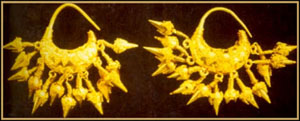 gold crescent earrings from ancient Assyria at the time of Nimrod and the building of the Tower of Babel. This was the period shortly after the flood and just prior to the birth of Abraham.
gold crescent earrings from ancient Assyria at the time of Nimrod and the building of the Tower of Babel. This was the period shortly after the flood and just prior to the birth of Abraham.
Notice each crescent fixes fourteen individual amulets with seven tiny links as moonbeams representing the lunar phases of each day. This is very possibly illustrating the relationship of two weeks of seven days of waxing lunar phases commencing with the first visible crescent after conjunction. In like manner, the second earring appears to reckon two weeks of waning lunar phases that end with the last visible crescent moon prior to the conjunction. Only the occulted dark lunar phase or phases are missing, which vary from one to two days. Thus, an entire month of visible lunar phases is depicted by the moonbeams while giving special honor to the Babylonian crescent moon god Sin.
As a result of their proactive presentation, the dark lunar phase is thus represented by the woman’s head, declaring her soul remained in abject and absolute occult darkness. So when an Assyrian woman wore these earrings, essentially, she was wearing her calendar honoring her pagan god and declaring that she, herself walked in darkness.
You are all the children of light, and the children of the day: we are not of the night, nor of darkness. 1 Thessalonians 5:5
For the purpose of contrast, I went searching online for a pair of whole round pearl earrings to represent the full New Moon (#3677 keh-seh). What I found was serendipitous as the description that accompanied this earring set states:
 “These earrings feature stars that twinkle in a silver firmament above the full moon.”
“These earrings feature stars that twinkle in a silver firmament above the full moon.”
Any woman wearing a set of whole round pearls such as these fundamentally declares that she honors the Creator’s astro-luni-solar calendar “from one New Moon to another,” which by design includes the four Sabbaths between them and all the annual Feast days they beacon. Her head is represented as the brilliant full New Moon, declaring that she, herself, walks in the marvelous LIGHT OF TRUTH.
D
Dawn – The growing appearance of light in the sky prior to sunrise. To begin to develop, expand or brighten like the light of dawn. Oxford English Dictionary, 1971.
Strong’s Concordance – defines Dawn as (NT # 4404 proi), — the Fourth Watch of the night; to begin to grow light.
Dawn is the time frame that occupies the Fourth Watch of the night and is not part of the morning at all. It is also known as the morning watch, as the action of this Fourth Watch of the night is to actively watch for the first rays of direct sunshine at sunrise. Each new day begins at sunrise according to Scripture’s weight of evidence and not at midnight, sunset, dawn, or noon. Refer to the article, Sunrise or Sunset, When Does a Day Begin?
Day – Weighty evidence defines the Scriptural day as a twelve-hour period of time from sunrise to sunset. Genesis 1:4 clarifies that the Creator first divided the light from the darkness calling the light day and the darkness night.
Etymology of Day —O.E. daeg “day,” also “lifetime,” from P.Gmc. dagaz (cf. O.S., M.Du., Du. Dag, O. Fris. Dei, O.H.G. tag, Ger. Tag, O.N. dagr, Goth. dags), from PIE dheigh-. Not considered to be related to L. dies (see diurnal), but rather to Skt. Dah “to burn,” Lith. Dagas “hot season,” O.Prus. dagis “summer.” Meaning originally, in English, “the daylight hours;” expanded to mean “the 24-hour period” in late Anglo-Saxon times.
Remember, the Jews rejected Yahusha as their Messiah, and they rejected the Renewed Covenant (NT or Brit Chadasha), which was about Him. Therefore they do not accept the following quote of the Messiah as evidence for the length of a day.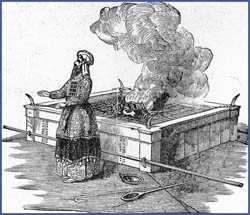
Yahusha answered, “Are there not twelve hours in the day? If anyone walks in the day, he does not stumble, because he sees the light of this world. But if one walks in the night, he stumbles, because the light is not in him.” John 11:9-10 NKJV
Consider the morning and evening sacrifices; these took place at sunrise and sunset Also, our Messiah died on the cross near the time of the evening sacrifice at the 9th hour, which was a full three hours prior to sunset.
There are seven days in each week, 29 or 30 days in each month, and 354-384 days in each year, depending on whether it is an embolismic year or not. However, all days are not created equal according to Scripture.
E
Easter – A Roman replacement for the three Scriptural sacred set-apart feasts, Feast of Passover, Feast of Unleavened Bread, and Feast of First Fruits. Yet, it is true Rome, through a process of “rules of postponement,” ensures that Easter will never fall on the Scriptural Passover because of their hatred of the Jews.
According to Rome:
. . . It appeared an unworthy thing that in the celebration of this most holy feast we should follow the practice of the Jews, who have impiously defiled their hands with enormous sin, and are, therefore, deservedly afflicted with blindness of soul. … Let us then have nothing in common with the detestable Jewish crowd; for we have received from our Savior a different way. Eusebius’ Life of Constantine, Book 3, Chapter 18
According to Rome:
Easter must be celebrated by all throughout the world on the same Sunday; that this Sunday must follow the fourteenth day of the paschal moon; that that moon was to be accounted the paschal moon whose fourteenth day followed the spring equinox; that some provision should be made, probably by the Church of Alexandria as best skilled in astronomical calculations, for determining the proper date of Easter and communicating it to the rest of the world. The Catholic Encyclopedia Easter Controversy
According to Rome:
The World Council of Churches proposed a reform of the method of determining the date of Easter at a summit in Aleppo, Syria, in 1997: Easter would be defined as the first Sunday following the first astronomical full moon following the astronomical vernal equinox, as determined from the meridian of Jerusalem. The reform would have been implemented starting in 2001, since in that year the Eastern and Western dates of Easter would coincide. This reform has not yet been implemented. Catholic Encyclopedia: “Easter Controversy”
Do not be deceived by the many methods of locating Easter. The real key to this process is in knowing what marks the beginning of each year and then which lunar phase is the true New Moon. From this, it is a matter of counting 14 days to Passover. Feast of Unleavened Bread begins the next day at sunrise, and the First Fruits Offering is waved Женские кроссовки adidas forum low 84 white Application адедас форум — цена 2049 грн в каталоге Кроссовки ✓ Купить женские вещи по доступной цене на Шафе , Украина #166398010 , Did These Yeezy Boost 350 V2 Oreo Really End Up At An Outlet on the 16th. This is one of the seven sacred appointed feast days ordained to be kept sacred each year perpetually, through to the second coming of our Messiah and Redeemer and beyond. According to Daniel 9:27, the “sacrifice and grain offering” were to cease, but not the feasts themselves, as they were rooted in the Temple above, the mechanism in the shamayim of restoring sinners back to the Almighty Father through a system that only commenced at the cross.
Eclipse – The total or partial obscuring of one celestial body by another.
Lunar Eclipse – A lunar eclipse will only occur at night when the moon has reached its perfect “full” New Moon state.
The earth then comes between the light of the sun and the moon and causes the moon to be obscured for several minutes.
Solar Eclipse – A solar eclipse can only occur during a dark conjunction lunar phase. During a solar eclipse the moon comes between earth and the sun during the daytime, causing the sun to be obscured by the moon. At any mention of a solar eclipse, there is an overt identification of the phase and position of the moon at that time, as it can only be in its “dark” conjunction lunar phase at the very point in time during which the eclipse occurs.
The prophet Amos says that the sun would be darkened on the day of the death of the Messiah (Amos 8:9-11). A full 800 years later, we have the testimony of three apostles, Matthew, Mark, and Luke, that indeed a solar eclipse occurred at noon lasting three hours.
What makes this eclipse particularly remarkable is that it lasted three hours. This is unheard of for a total eclipse to last more than 45 minutes from start to finish. Truly, this was an emphasis that could only be produced by the Almighty Father, the Creator of the shamayim.
Eighth Day, Feast of – This eighth day is the day following the seven-day Feast of Tabernacles, which would place it on the 22nd day of the Seventh Month, Ethanim, counting from the New Moon. This eighth day falls on the seventh-day Sabbath each and every year. It is only the eighth day because it is referred to as following the seven-day Festival of Tabernacles (Leviticus 23:36, 39). According to John 9:6-14, the Messiah avouches that this “eighth day” was to be utilized for administrating circumcision by the Priests. Refer to the article, Restored Prophetic Feast Days of Yahusha the Messiah.
Elul – This is the only name recorded in Scripture for the sixth lunar month of the astro-luni-solar calendar (Nehemiah 6:15). Yet, it appears to be of Babylonian origin.
Embolismic – “The insertion of a day or other period of time into a calendar, as in leap year” (ibid.). The embolismic year on the Jewish astro-luni-solar calendar was 13 months/lunations long. The purpose was to reconcile the shorter lunar year to the longer solar year with the addition of an extra month. For more on this, see the Metonic cycle.
Equinox – An equinox is an astronomical event in which the plane of Earth’s equator passes through the center of the Sun, which occurs twice each year, around 20 March and 23 September. During the 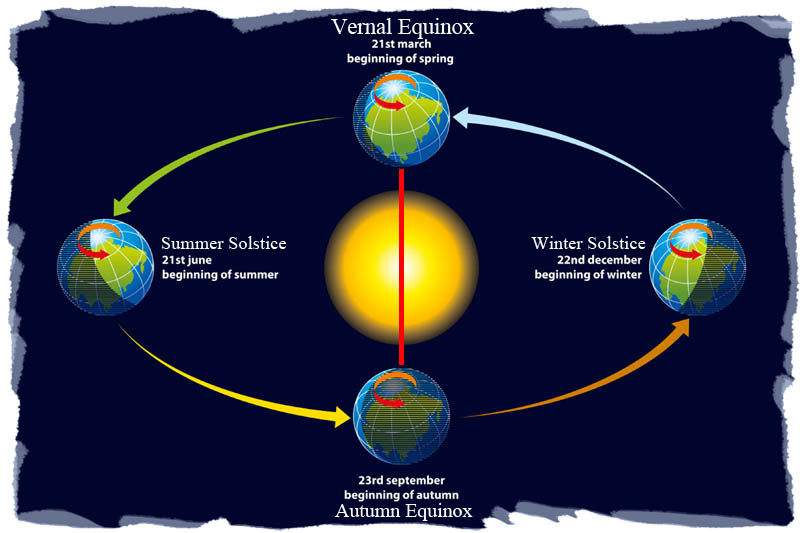 equinox, day and night are of approximately equal duration all over the planet. They are not exactly equal, however, due to the angular size of the sun and atmospheric refraction. To avoid this ambiguity, the word equilux is sometimes used to mean a day in which the durations of light and darkness are equal. Wikipedia
equinox, day and night are of approximately equal duration all over the planet. They are not exactly equal, however, due to the angular size of the sun and atmospheric refraction. To avoid this ambiguity, the word equilux is sometimes used to mean a day in which the durations of light and darkness are equal. Wikipedia
Ethanim – This is the only name recorded in Scripture for the seventh lunar month of the astro-luni-solar calendar (1 Kings 8:2). It appears to be attributed to Babylon.
F
First Fruits (Raysheeth) Annual Rehearsal of the Prophetic Lamb to be Resurrected – Leviticus 23:9-15
This feast day is part of the Passover week and is often referred to as Wave Sheaf and occupies the 16th day of Abib and is also permanently fixed to the first day of the lunar week. This day follows the seventh-day Sabbath of the 15th today, just as it did at the time of Moses and during the three days of the crucifixion and resurrection of Yahusha. This is a “nail in a sure place.” Leviticus 23:9-15, Matthew 28:1-8
The waving of the first fruits of the ripened barley harvest occurs right on time because the full moon, together with the constellation Bethulah, identifies the authentic Biblical New Year providing the barley will be ripened at the correct time.
This feast was time centric to fulfilling the Messiah typology that was to come, as He was ordained from the beginning to lay down His life as a Lamb sacrifice. He was preordained to be raised from death to life on the third day, on the appointed Feast of First Fruits. All those who trusted in the promise of salvation and ultimate resurrection to new life, both previous and subsequent to His death and resurrection, were and are dependent upon the Messiah’s success as our innocent sin replacement. His death and resurrection occurred precisely on time according to the astro-luni-solar calendation model. This prophetic Feast of First Fruits of Abib 16, A.D. 31, was fulfilled at our Savior’s nike dunk duck olive garden ohio city cleveland, Жилетка, жилетка nike — цена 2000 грн в каталоге Жилетки ✓ Купить мужские вещи по доступной цене на Шафе, осанка жилетка , Украина #131833407 resurrection from death unto life and utter darkness unto light. This resurrection gives hope to all for a future beyond the grave. As He rose bodily, so shall the saints on that great and coming day be raised to a newness of life.
For Yahusha, Himself will descend from the shamayim with a shout, with the voice of an archangel, and with the trumpet of Alahim. And the dead in Messiah will rise first. Then we who are alive and remain shall be caught up together with them in the clouds to meet Yahusha in the air. And thus we shall always be with Yahusha. Therefore comfort one another with these words. 1 Thessalonians 4:16-18 NKJV
Overwhelming evidence for astro-luni-solar calendation is revealed in the following text. Notice Moses has recorded that this feast day occurs on the day following the seventh-day Sabbath. This Sabbath mentioned is always the 15th of Abib because Passover is always on the 14th of Abib, as counted from the full New Moon day. Therefore, this text illustrates that while the month dates are counted from the New Moon, the Sabbaths are also fixed to specific days of the week, i.e., the seventh. If this was not the case, Moses would not have stated that this feast occurs on the day after the Sabbath. Continuous weekly cycles simply cannot be harmonized with any of the Feast days, as all of their dates are fixed to days of the week for the simple reason that they float throughout the lunar month model.
He shall wave the sheaf before Yahuah, to be accepted on your behalf; on the day after the Sabbath the priest shall wave it. And you shall offer on that day, when you wave the sheaf, a male lamb of the first year, without blemish, as a burnt offering to Yahuah. Leviticus 23:11-13 NKJV
Easter, “Feast of the Resurrection,” is Rome’s counterfeit holiday for the Passover, Feast of Unleavened Bread, and specifically, First Fruits. This colorful amalgamation of pagan myth and Scriptural truth has taken the whole world captive, corrupting the inherent facts, legitimacy, and prophetic application to the work of our Savior on mankind’s behalf in restoring us back to Himself.
Most are not aware of Rome’s system of fixing Easter to the first Sunday after the full moon since the time of the Council of Nicaea (A.D. 325). This full moon is the one that falls on or after the vernal (spring) equinox. As a result, Easter is likewise calculated according to the count from the New Moon, with the added stipulation of the first Sunday following it. Although the Gregorian calendar, with its continuous weekly cycle, is not in harmony with the Scriptural astro-luni-solar calendar, on occasion, Rome’s Easter Sunday will occur on the same day as the Scriptural Passover (Raysheeth). Refer to the article, Why Must Rome Fix Easter to the Moon?
Feast Days – The divinely appointed Feast Days as recorded in Leviticus 23:1-4 are divided into three categories: 1) weekly, 2) monthly, 3) yearly:
Sabbath (Shabbat) – The Creator’s divinely appointed day of rest was scheduled to occur every seventh day following each New Moon Day. There are exactly four seventh-day Sabbaths every lunar month, which consistently fall upon the lunar calendar dates of the 8th, 15th, 22nd, and 29th. The seventh-day Sabbath is the first of eight sacred appointed feast days listed in Leviticus 23:1, but not the first Feast Day of the Year.
Sabbath and New Moon, both periodically recur in the course of the year. The New Moon is still, and the Sabbath originally was, dependent upon the lunar cycle. Universal Jewish Encyclopedia, p. 410.
Yeshua [Yahusha]…observed a Sabbath, but this Sabbath was neither Saturday nor Sunday. The Nazarene Sabbath was a lunar Sabbath . . . Of the lunar month. (A lunar month starts on the New Moon). This was standard practice among the Beni-Aumen Nazarene Order and most of the other orthodox Jewish sects of the time…Lunar Sabbath observance is an ancient Semitic custom concurrent and ante-dating the time of Yeshua . . .” (ibid.). Shawui Sabbath: Ancient Sabbath Observance
The connection of the Sabbath with lunar phases, however, was (later) discarded by the Israelites [as pressurred by their Roman captors]. . . The New Schaff-Herzog Religious Encyclopedia, p. 135-136.
The foundational premise of all the sacred appointed feast days is that they are lunar and remain THE FEASTS OF YAHUAH, and DO NOT belong to ancient Israel, the modern Jews, nor are they the property of the Christians that they might be annulled. The set-apart Feast Days belong to our Creator and His Son, the Messiah, the prophetic promised LAMB. They have been bequeathed to all created beings upon planet Earth as sacred rehearsals of prophetic events to be fulfilled by the Messiah, alone, in real-time. But even then, those Feast Days that have already been fulfilled were designed to continue on as memorial celebrations until the complete restoration occurred following the Messiah’s second coming.
For details on the Feast Days, refer to the following article:
Restored Prophetic Feast Days of Yahusha the Messiah
Discover the difference between the Set-apart Feast Days of Yahuah as found in Leviticus as compared to the restored Prophetic Feast Days of Yahusha the Messiah, as born out on the Menorah.
Full Moon – Renewed and rebuilt lunar phase.
Foundational anchor points to the historical perspective have been recently discovered in François Lenormant’s “Origines de l’Histoire” (History of the Origins), published in 1880 and recorded in the 1911 Encyclopaedia Britannica, p. 993. He was a French Assyriologist, meaning an archeologist of Assyria and Babylon. He identified that the early Mesopotamia culture utilized the full moon as the start of months and years. Remember, this was the first civilization following the flood. This represents the first and second generations of Noah who, along with his family of eight, had remained faithful to their Creator and, as a result, were saved in the ark.
“Assyria and Babylonia—The twelvefold division of the zodiac was evidently suggested by the occurrence of twelve full moons in successive parts of it in the course of each year. This approximate relation was first systematically developed [or maintained] by the early inhabitants of Mesopotamia and formed the starting point for all other divisions of time… [Later] The idea of tracing the sun’s path among the “stars” [by daylight] was when it occurred to Chaldaean astronomers, an originaland, relatively to their means, a recondite one. We owe to its realization by them the constitution and nomenclature of the [modern] twelve signs of the zodiac.” 1911 Encyclopaedia Britannica – Zodiac, p. 993, Lenormant, Orgines de l’Histoire, Vol. 1, p. 236.
As identified in his quote above, originally, it was twelve full moons in their order that designated the lunar months of each year. And because full moons occur by night, they consistently measured the night sky together with the stars exactly as defined by the four witnesses of Scripture as found in Genesis 1:16, Psalms 136:7-9, Jeremiah 31:35-36, and Revelation 12:1.
Secondly, and of equal importance, this quote also validates that it was the full moons that formed the starting points for ALL other divisions of time. As a result, it includes the time division of Years, Months, Weeks, and Days. And by extension, the authentic seventh-day Sabbath, the sacred worship day of our Creator that has existed from eternity past. So contrary to the modern Rabbinical and Karaite Jews’ Saturday, as found on the modern Roman replacement solar calendar, His Kadosh (holy, sacred, and set-apart) seventh-day Sabbath has and will always be measured from full moon to full moon through all eternity. This is, therefore, a nail in a sure place as it is in harmony with all of Scripture and astronomy!
Thirdly, note that from the same quote above on page 993 of the 1911 Encyclopaedia Britannica, still quoting from François Lenormant’s “Origines de l’Histoire” (History of the Origins), he identifies that years later, the Chaldaean astronomers from this same region [likely under the leadership of Nimrod and Semiramis], invented and introduced the method of measuring time by tracing the sun’s path among the starry constellations of the zodiac by daylight. The term utilized to describe this variance from the original method of utilizing the full moon was a “recondite” one. The term “recondite” means concealed, hidden, and secret.
So what exciting evidence is brought to light by the discovery of this quote, and what does it all mean? The full moon was Rosh (head/ first) of all divisions of time, including the Year, Month, Week, and count of Days among the faithful early descendants of Noah who worshiped the one true Yahuah Alahim, our Creator. Then later, the Chaldaean astronomers from the same region, likely under the leadership of Nimrod during the time of building the Tower of Babel, were the originators of the counterfeit and replacement time-measuring system so popular to this day. They single-handedly changed Yahuah Alahim’s time-centric laws by inventing a new method of measuring time, entirely out of sync with the original. This may have been the pivotal issue in tandem with building the tower that fomented their rebellion against the Creator. They desired to implement a luni-solar method of measuring the stars with the sun by day when the stars are invisible and hidden. By extension, although not overtly stated, the dark moon, in conjunction with the sun, was introduced and utilized to mark the start of years and months from that moment onward.
This was the inception and beginning when the new “secret or hidden” luni-solar system was crafted and commenced each year and month, a full 180 degrees opposite that of our Creator’s preordained time-measuring model. Might this be the primary reason for the destruction of the Tower of Babel, the confusion of the languages, and the scattering of the people unto all regions of the earth?
In those early years among the faithful and obedient of Yahuah Alahim, following the flood, no wall calendars, wristwatches, or international datelines were needed because all were perfectly incorporated into the rhythm of the lights high above out of the reach of man and beast. Each unit of time was ordained to fit perfectly into the next larger unit with no overlapping. This is because they were all beaconed by the same trinity of lights, with the full moons marking the starting points of all the divisions of time in a marvelous pattern and rhythm that distinguished each one apart from the rest. This reality alone provides a consistent and visual platform through which mankind may rendezvous with their Creator for all His sacred lunar appointed times.
G
Geocentric Model (Geocentricism) – Earth is at the orbital center of all celestial bodies. This model served as the predominant cosmological system in many ancient civilizations, such as ancient Greece, including the noteworthy systems of Aristotle and Ptolemy. As such, they assumed that the Sun, Moon, stars, and naked-eye planets circled Earth. Wikipedia
We at the Creator’s Calendar continue to keep an open mind with regard to this view of the Geocentric Model in contrast to the popular Heliocentric Model.
Golden Number – The Golden Number received its name as the Romans utilized the astro-luni-solar calendar to place Easter on the first Sunday after the full moon (as their recognized New Moon circa 4th century A.D.), following the Vernal Equinox. Each year of the 19-year Metonic cycle, the first full moon is marked with the Golden Number.
So it is that the first full moon of the 19-year cycle is marked with the golden #1, the second full moon of the 19-year cycle is thus marked with the golden #2, and so on through the course of the 19-year cycle. Over the course of 50 or 100 years of tabulations, one can look at the cycles and know that all the years with the same Golden Numbers occurred on or near the same day of the Roman solar year. The Golden Numbers are a simple way to tabulate the natural syncopation process of the full moons each year and over the course of 19, which brings them back into “nearly” perfect harmony with the spring vernal equinox. In actuality, the 19-year cycles can be off, up to 2 hours at times. So mathematicians have discovered that this same cycle utilized over a period of 236 years is perfection.
The simple fact that the Roman Catholic Church continues to this day to locate Easter according to the first Sunday after the full moon, following the Vernal Equinox, testifies that the Metonic cycle has always determined the sequence of 12 and 13 lunar months over the 19-year lunar cycle. This would have been the same time-measuring system of Adam and Eve, Enoch, Noah, Abraham, Moses, David, Isaiah, Jeremiah, Ezekiel, Daniel, and our Messiah with His disciples and the apostles after Him. It is time to restore what has been removed by the Roman Emperors.
Gregorian Calendar – A corrected form of the Julian calendar, introduced by Pope Gregory XIII in 1582 and now used in most countries of the world: it provides for an ordinary year of 365 days and a leap year of 366 days every fourth even year, exclusive of century years, which are leap years only if exactly divisible by 400″ (ibid.). The Julian calendar flowed smoothly into the Gregorian without any disruption of the continuous weekly cycle. It removed ten days from the year in order to bring Easter back into alignment with the vernal equinox.
In addition, to the artificial time elements introduced by Julius Caesar and Pope Gregory, very little is said about the changes to the Julian calendar contrived by Emperor Hadrian and Constantine between the 2nd and 4th centuries A.D., prior to Pope Gregory’s changes. Hadrian and Constantine took the eight-day nundinal Julian calendar and changed it to the seven-day cycling week. Constantine then declared that this same week has continued unbroken since creation and was utilized at the cross of the Messiah. But, nothing can be further from the truth as Scripture is the standard portrayed within the Temple model of astro-luni-solar time. See also Hadrian, Emperor.
“The modern seven-day week came into use during the early imperial period, after the Julian calendar came into effect, apparently stimulated by immigration from the Roman East. For a while it coexisted alongside the old 8-day nundinal cycle, and fasti are known which show both cycles. It was finally given official status by Constantine in 321.” Roman Calendar Encyclopedia, Days of the Week.
H
Hadrian, Emperor – This change from the astro-luni-solar to a fixed solar calendar occurred in Rome during the repressive measures which were enacted against ALL Jewish customs . . . during the reign of Emperor Hadrian. With the fall of the Nazarene headquarters…at Jerusalem, this new Roman calendar quickly spread throughout ‘Christendom.’ This new calendar not only replaced yearly festival dates such as Passover but also revamped the concept of the week and its seventh day. Iranaeus 2nd Century A.D.
Hebrew Calendar – The Hebrew calendar (הלוח העברי ha’luach ha’ivri), or Jewish calendar, is an astro-luni-solar calendar used today predominantly for Jewish religious observances. It determines the dates for Jewish holidays and the appropriate public reading of the Torah portion (dates to commemorate the death of a relative), and daily Psalm reading, among many ceremonial uses. In Israel, it is an official calendar for civil purposes and provides a time frame for agriculture.
The Hebrew calendar has evolved over time. For example, until the Tannaitic period (approximately 10–220 CE), the months were set by observation of a new moon, with an additional month added every two or three years to correct for the difference between twelve lunar months and the solar year, and therefore, to keep Passover in the spring. The addition of the extra month was also based on observation of natural events, namely the ripening of the barley crop, the age of the kids, lambs, and doves, the ripeness of the fruit trees, and the relation to the seasons.
The twelve regular months are: Nisan (30 days), Iyar (29 days), Sivan (30 days), Tammuz (29 days), Av (30 days), Elul (29 days), Tishrei (30 days), Marcheshvan (29 or 30 days), Kislev (29 or 30 days), Tevet (29 days), Shevat (30 days), and Adar (29 days). In the leap years (such as 5771) an additional month, Adar I (30 days) is added after Shevat, and the regular Adar is referred to as “Adar II”.
“. . . the Jewish festivals being regulated solely by the moon, may fall on any day of the [Roman] week.” Oxford English Dictionary, 1971 Edition, Vol. 2, “Pentecost.” [Emphasis mine]
“The [early] Hebrews employed lunar seven-day weeks, which ended with special observances on the seventh day, but none the less were tied to the moon’s course.” Rest Days, Hutton Webster, p. 254-255 [emphasis mine]
The weeks do not continue in a regular cycle regardless of the moon. Each month has four weeks, the beginning with the New Moon. I have no doubt that this was the old Hebrew system. Babylonian Menologies and the Semitic Calendars, p. 89.
“The connection of the Sabbath with lunar phases, however, was (later) discarded by the Israelites . . .” The New Schaff-Herzog Religious Encyclopedia, p. 135-136. [Emphasis mine]
“The invention of the continuous week was therefore one of the most significant breakthroughs in human beings’ attempts to break away from being prisoners of nature [and from under God’s law] and create a social world of their own.” The Seven Day Circle: The History and Meaning of the Week, Eviator Zerubavel, New York: The Free Press, 1985. p.11.
Heliocentric Model (Heliocentrism) – This is the astronomical model in which the Earth and planets revolve around the Sun at the center of the Solar System. The word comes from the Greek (helios, “sun,” and kentron “center”). Historically, heliocentrism was opposed to geocentrism, which placed the Earth at the center. The notion that the Earth revolves around the Sun had been proposed as early as the 3rd century BC by Aristarchus of Samos, but at least in the Post-ancient world, Aristarchus’s heliocentrism attracted little attention – possibly because of the loss of scientific works of the Hellenistic Era. Wikipedia
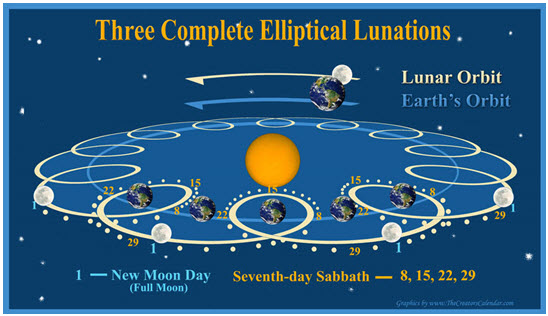 We at the Creator’s Calendar have adopted the Geocentric Model in contrast to this popular Heliocentric Model and will be changing many of our graphics to reflect it more fully. More will be coming soon on this important subject and the gravity of its implications.
We at the Creator’s Calendar have adopted the Geocentric Model in contrast to this popular Heliocentric Model and will be changing many of our graphics to reflect it more fully. More will be coming soon on this important subject and the gravity of its implications.
High Sabbath – There are two High Sabbaths each and every year. This is when an appointed Feast Sabbath commences on a weekly seventh-day Sabbath, such as in the case of the Feast of Unleavened Bread in the spring and the Feast of Tabernacles in the fall. Counting from the “full” New Moon, both feasts begin on the 15th day of the month and end on the 21st day.
Hillel II – In A.D. 358, Sanhedrin Patriarch Hillel II, motivated by the onslaught of continued Jewish persecution, determined to provide an authorized mathematically-based calendar for all time to come that would be in harmony with Rome. By so doing, he severed the ties that united the Jews of the Diaspora to their historical Scriptural roots and to the Patriarchate. It is recorded that Rome’s unbroken-cycle-of-weeks of seven days was adopted at a clandestine and maybe final meeting of the Sanhedrin in A.D. 358, marking the last universal decision made by that body. Thus the Jews swapped Scriptural lunar Sabbaths for the popularized Roman unbroken-cycle-of-weeks, causing her Sabbaths to no longer be in sync with the New Moons and all other sacred appointed feasts.
It appears that in addition to changing the form of the week for all future generations, they also changed their recognition of which lunar phase was the New Moon. There is much support for this, beginning with the article, Announcing an Official Paradigm Shift.
Horology – The study of daylight hours. Hours are the measurement of time as used by the sundial during the daylight in contrast to measuring time during the dark of night. Nights were never measured by hours as the sun was not present to shine on the sundial, rather they were measured by four watches (Mark 13:35). According to the Messiah Yahusha, the Hebrew day consisted of only twelve hours (John 11:9). The length of each hour varies according to the time of year, yet there remain twelve.
Hours – Hours are the measurement of time used by the sundial during daylight in contrast to measuring time during the dark of night. Nights were never measured by hours as the sun was not present to shine on the sundial, rather they were measured by four watches (Mark 13:35). According to the Yahusha the Messiah, the Hebrew day consisted of only twelve hours (John 11:9). The length of each hour varies according to the time of year, yet there remain twelve.
I
Intercalary – (from Lat. intercalare, to proclaim, calare, the insertion of a day in the calendar), a term applied to a month, day, or days inserted between other months or days in order to adjust the reckoning of time, based on the revolution of the earth round the sun, the day, and of the moon around the earth, the lunar month, to the revolution of the earth round the sun, the solar year. From the meaning of something inserted or placed between, intercalary is used for something which interrupts a series or comes between two types. In botany, the term is used for growth that is not apical but somewhere between the apex and base of an organ, such as the growth in length of an Iris leaf or of the internode of a grass-haulm. 1911 Encyclopaedia Britannica, Intercalary, Volume 14, p. 683.
Intercalations – Traditionally, intercalations were determined at meetings of a special calendar commission of the Sanhedrin. But Constantius II, following the precedents of Hadrian, prohibited the holding of such meetings. However, the Jewish community outside the land of Israel depended on the calendar sanctioned by the Judean Sanhedrin for the proper observance of the Jewish sacred days. However, danger threatened the participants in that sanction and the messengers who communicated their decisions to distant congregations. Temporarily, to relieve the foreign congregations, Huna ben Abin once advised Rava not to wait for the official intercalation:
When you are convinced that the winter quarter will extend beyond the sixteenth day of Nisan declare the year a leap year, and do not hesitate (R. H. 21a). There is a popular tradition, first mentioned by Hai Gaon (d. 1038 CE), that as religious persecutions continued, Patriarch Hillel II, determined to provide an authorized mathematically-based calendar for all time to come, though by so doing he severed the ties which united the Jews of the diaspora to their mother country and to the patriarchate. It is recorded that the calendar was adopted at a clandestine, and maybe final, meeting of the Sanhedrin in A.D. 358, marking the last universal decision made by that body.
J
Jericho—This is the Hebrew word for moon. (yerecho (H#3405 – ירחו – moon, month).
Jericho (Ya rach oh #3405) means “moon” (ya rach #3394). It was the heathen city of the Babylonian Crescent Moon-god “Sin,” which sat at the gate of Israel’s entrance to the Promised Land. Yahuah commanded Joshua to march 13 times in a “full circle” around this “crescent city” to reclaim it for Himself and His people. As the story is written, Israel marched once each night, during the fourth watch, for six nights, and on the seventh night, they marched seven times and shouted and blew their trumpets. The blowing of the trumpets was the sign to call all of the hosts of the shamayim to win this battle for them (Numbers 10:9). It was only a 15-minute walk around Jericho. The image at the right depicts the broken-down ruins of ancient Jericho.
 This image at the left is a modern monument set up in honor of Jericho. Placed on the very top of the monument is a crescent moon, and the inscription on the sign states, “Jericho, City of the Moon.” This is self-evident that it was the “crescent” that was worshiped and deemed the true New Moon to start each month by its pagan inhabitants. For this reason, Yahuah had to destroy the city.
This image at the left is a modern monument set up in honor of Jericho. Placed on the very top of the monument is a crescent moon, and the inscription on the sign states, “Jericho, City of the Moon.” This is self-evident that it was the “crescent” that was worshiped and deemed the true New Moon to start each month by its pagan inhabitants. For this reason, Yahuah had to destroy the city.
Forty years previous, Israel has been miraculously rescued from the clutches of the Egyptians, who reckoned all time and events from the dark moon as their New Moon. So now it is established that both the dark moon and the crescent were the witty inventions of man and not of the Creator or His true calendar.
When Israel fell into disgrace and sinned against Yahuah in worshiping the pagan gods, one of them was the crescent moon god “Sin.”
Depending upon which translation you utilize, you will find that Judges 8:21, 26 refers either to round gold ornaments worn around the necks of camels or that they were in the shape of a crescent. My personal belief is that this is another example found among the heathen attributing their fondness to the crescent shape representing the deity moon god Sin. You will find these same results in a Hebrew lexicon or concordance.
This image contains a matching set of  gold crescent earrings from ancient Assyria at the time of Nimrod and the building of the Tower of Babel. This was the period shortly after the flood and just prior to the birth of Abraham.
gold crescent earrings from ancient Assyria at the time of Nimrod and the building of the Tower of Babel. This was the period shortly after the flood and just prior to the birth of Abraham.
Notice each crescent fixes fourteen individual amulets with seven tiny links as moonbeams representing the lunar phases of each day. This is very possibly illustrating the relationship of two weeks of seven days of waxing lunar phases commencing with the first visible crescent after conjunction. In like manner, the second earring appears to reckon two weeks of waning lunar phases that end with the last visible crescent moon prior to the conjunction. Only the occulted dark lunar phase or phases are missing, which vary from one to two days. Thus, an entire month of visible lunar phases is depicted by the moonbeams while giving special honor to the Babylonian crescent moon god Sin.
As a result of their proactive presentation, the dark lunar phase is thus represented by the woman’s head, declaring her soul remained in abject and absolute occult darkness. So when an Assyrian woman wore these earrings, essentially, she was wearing her calendar honoring her pagan god and declaring that she, herself walked in darkness.
You are all the children of light, and the children of the day: we are not of the night, nor of darkness. 1 Thessalonians 5:5
For the purpose of contrast, I went searching online for a pair of whole round pearl earrings to represent the full New Moon (#3677 keh-seh). What I found was serendipitous as the description that accompanied this earring set states:
 “These earrings feature stars that twinkle in a silver firmament above the full moon.”
“These earrings feature stars that twinkle in a silver firmament above the full moon.”
Any woman wearing a set of whole round pearls such as these fundamentally declares that she honors the Creator’s astro-luni-solar calendar “from one full New Moon to another,” which by design includes the four Sabbaths between them and all the annual Feast days they beacon. Her head is represented as the brilliant full New Moon, declaring that she, herself, walks in the marvelous LIGHT OF TRUTH.
Jubilee — a Jubilee represents fifty years. It is made up of seven weeks of years (sabbatical or shemitah years) plus the fiftieth year. This works similarly to the Yahuah’s New Moon to New Moon cycle in that the weeks are contained within and do not cycle through the New Moon. With lunar months there are always four weeks of days, but with the Jubilees, there are always seven weeks of years, with the 50th year as the final set-apart year.
“And you shall consecrate the fiftieth year, and proclaim liberty throughout all the land to all its inhabitants. It shall be a Jubilee for you; and each of you shall return to his possession, and each of you shall return to his family. 11 That fiftieth year shall be a Jubilee to you; in it you shall neither sow nor reap what grows of its own accord, nor gather the grapes of your untended vine.” Leviticus 25:10-11. See also verses 12-54
The greater majority of folks worldwide that utilize the count to Jubilee and the sabbatical years for growing crops and measuring time have eliminated the 50th year as a separately counted year and only count seven weeks of years, and then they overlap the 50th year onto the first year of the next Jubilee cycle. So they are never counting more than seven weeks of years, equaling 49 years.
But we believe this is incorrect, for it is out of sync with other related time principles of the Creator’s Calendar, such as the principle of the New Moon and the lunar Sabbath. Understanding how the New Moon is a separate kind of day that refreshes the four cycling weeks makes it impossible to lose track of weeks because they can never overlap.
Additional evidence from the Hebrew text shows that the word “consecrate” (qadash קדשׁ #6942), as shown above, literally means – sanctify, set apart for sacred use, dedicate as sacred. Thus, the entire 50th year was to be set apart for sacred (holy) use. Something simply cannot be both set apart and used for regular purposes at the same time. This is like saying the traffic signal can be both green and red at the same time. The more we seek knowledge of the truth, the more clearly the long-held errors and lies passed down to us are now exposed for what they are.
Julian Calendar – Calendar established by Julius Cæsar in 46 B.C. Every fourth year was given 366 days, the other years having 365 days each: the months were the same as in the Gregorian or new style calendar now used.”
In the Roman Julian calendar below, the days of the week are alphabetized from A – H in columns illustrating there were eight days in each artificial week instead of the seven that we have today. The X’s and I’s along the bottom tell the length of each artificial month. This is a copy of an ancient stone carving. The first day of January began with the first day of the week, marked by an A.
K
Kohen – Hebrew Priest, while Kohenim is the plural form of Kohen.
L
Laodicea, Council of (Canon 29) – Most Saturday Sabbatarians have been taught to believe that the Council of Laodicea, Canon 29 stated:
“Christians shall not Judaize and be idle on Saturday, but shall work on that day; but the Lord’s Day they shall especially honor, and, as being Christians, shall, if possible, do no work on that day. If however, they are found Judaizing, they shall be shut out from Christ.” Council of Laodicea, Canon 29
Karl J. von Hefele, a Catholic bishop, in his History of the Councils of the Church from the Original Documents, states that the word Saturday (dies Saturni) does not exist either in the Greek or Latin text. Rather, the word “Saturday” was supplied in the English translation instead of the word Sabbato, meaning Sabbath.
“Quod non oportet Christianos Judaizere et otiare in Sabbato, sed operari in eodem die. Preferentes autem in veneratione Dominicum Diem si vacre voluerint, ut Christiani hoc faciat; quod si reperti fuerint ir jordan 3 whataburger custom Judaizere Anathema sint a Christo.” Council of Laodicea, Canon 29
At the time the Julian calendar was being enforced upon their Christian followers for religious purposes, no one confused the word Sabbato with dies Saturni. Simply everyone at that time knew these were names for two different days on two distinctly different calendar systems. It is only as the facts of history have been forgotten that “Saturday” has been assumed to be the seventh-day Sabbath of Scripture.
This historic quote from the Council of Laodicea, Canon 29, applies to astro-luni-solar time-keeping only and not to the Gregorian calendar, which keeps the rhythm of the pagan unbroken cycles of weeks. This time-keeping was betrothed to mankind as an oracle of the government of the shamayim, the rhythm of the Temple above, and was the only time system consistently kept by the Hebrew people during their times of obedience.
These . . . eventually led Jewish rabbis to call Saturn Shabbti, ‘the star of the Sabbath.’ It was not until the first century of our era, when the planetary week had become an established institution that the Jewish Sabbath seems always to have corresponded to Saturn’s Day [Saturday]. Rest Days, p.244 by Hutton Webster
Lunar Cycles – Lunar cycles are varied and extremely complex, and yet the moon has more effect on the Earth than any other body except the Sun. Not only are ocean tides important in shaping the earth and are affected more by the moon than the Sun, but tides in the air are important for determining the weather, which in turn affects so many other variables, from plants and crops to animals and the economy.
The simplest cycle of the moon is the daily rising and setting, which gets later each day by about 49 minutes,, and this is the major component of tides that occur twice per day. Therefore tides move through each hour of the day twice in every 29.53-day lunar phase cycle.
In modern times many countries keep a solar calendar that arbitrarily fixes the year for 12 months. But the Creator’s Calendar beaconed in the shamayim utilizes the full New Moon in correlation with the stars by night and identifies 12.368 months in an astro-luni-solar year. Calendars that utilize the moon and the stars for months must insert an extra month about every 2.72 years. This 2.72-year cycle brings lunar phases back to the same time of the year, but because 2.72 is not near an integer, it only does so approximately, and more similar lunar phases at the same time of year occur after 8, 11, or 19 years.
The word “month” may be used to mean many different things, with the calendar month of over 30 days being the only one not related to the moon. The phases repeat in 29.53 days . . . Cycles Research Institute.org, Astronomy Lunar.
Lunar Months – The word month (or Chodesh in Hebrew, see Strong’s #2320) in Scripture specifically means New Moon or lunar month.
The Creators Calendar staff recognizes on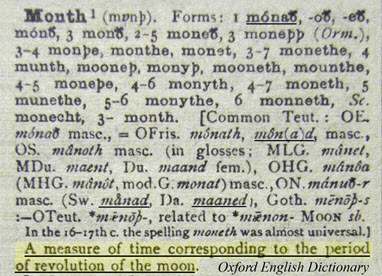 ly the Creator’s Lunar International Dateline (CLID). An imaginary line from the North to the South Pole is located on Earth as it is signaled according to the first sighting of the “full” New Moon. Because the moon is mobile, the Creator’s Lunar International Dateline is mobile, as it moves to a new location on Earth each lunar month. This divine phenomenon will beckon Yahuah’s obedient followers to be watchful and keep looking up to the Father of Lights.
ly the Creator’s Lunar International Dateline (CLID). An imaginary line from the North to the South Pole is located on Earth as it is signaled according to the first sighting of the “full” New Moon. Because the moon is mobile, the Creator’s Lunar International Dateline is mobile, as it moves to a new location on Earth each lunar month. This divine phenomenon will beckon Yahuah’s obedient followers to be watchful and keep looking up to the Father of Lights.
This is repeated each and every month for twelve (or thirteen) months. The month consists of 29 or 30 days. Six months of every year are 29 days in length, and the other six are 30 days, usually rotating every other month, but not always.
The Creator ordained that His lunar months be numbered from 1 – 12 and 13. Abib/Aviv was a name utilized in place of the first month. Exodus 13:4, Exodus 23:15, Exodus 34:38, Deuteronomy 16:1. 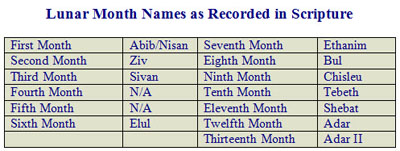 Babylonian Lunar Month Names Recorded in Scripture
Babylonian Lunar Month Names Recorded in Scripture
- Nissan – Nehemiah 2:1, Esther 3:7
- Ziv/Zif – 1 Kings 6:1, 1 Kings 6:37
- Sivan – Esther 8:9
- Fourth – N/A
- Fifth – N/A
- Elul – Nehemiah 6:15
- Ethanim – 1 Kings 8:2
- Bul – 1 Kings 8:2
- Chisleu – Nehemiah 1:1, Zechariah 7:1
- Tebeth – Esther 2:16
- Shebat –
- Adar – Joshua 15:3, Ezra 6:15, Esther 3:7, Esther 3:13, Esther 8:12, Esther 9:1, Esther 9:15, Esther 9:17, Esther 9:19, Esther 9:21.
- Adar II – N/A
- It is interesting that each of the Babylonian names is used only one or two times except in the case of “Adar,” in which there are ten, and none for “Adar II.”
- And because it remains a fact to this day that a thirteenth month (Adar II) does occur on a regular Metonic cycle schedule, unmanipulated by mankind, several of the verses supporting the month of Adar are rather suspect. These are the ones that refer to the thirteenth day of the twelfth month. These could have easily been inverted from the twelfth day of the thirteenth month without compromising the count of words on the page. These are Esther 3:13, Esther 8:12, Esther 9:1, and Esther 9:17.
- Who would have been motivated to make this alteration? Primarily the Romans when they established their new solar calendar of twelve months. This was during the time the Jews remained in Roman captivity and were subject to the desires of Roman Emperors.
Lunar Month Length – a measure of time corresponding or nearly corresponding to the length of time required by the Moon to revolve once around the Earth.
The synodic month, or complete cycle of phases of the Moon as seen from Earth, averages 29.530588 mean solar days in length (i.e., 29 days 12 hours 44 minutes 3 seconds)… [The moon automatically presents either a 29-day month or a 30-day month rotating approximately every other month. This is the only lunar phase count visible to mankind on Earth. All early civilizations utilized this visible display each lunar month.]
The sidereal month is the time needed for the Moon to return to the same place against the background of the stars, 27.321661 days (i.e., 27 days 7 hours 43 minutes 12 seconds); the difference between synodic and sidereal lengths is due to the orbital movement of the Earth–Moon system around the Sun…
As a calendrical period, the month is derived from the lunation—i.e., the time elapsing between successive new moons (or other phases of the moon). A total of 12 lunations amounts to 354 days and is roughly a year. A period of 12 lunations was therefore used by some primitive peoples to make their calendrical year. As is obvious, the lunar-based year (and a calendar derived from it) cannot be accurately correlated with a solar-based year, and the month’s continued use in the Gregorian calendar of modern times is merely a recognition of its convenience as a calendar division. https://www.britannica.com/science/month#ref225844
Lunar Sabbath – The early Hebrews kept their Sabbath according to the count from the New Moon. Dies Saturni of the Roman calendar was never synonymous with the lunar Sabbath, as the two calendars can never be harmonized. Several years after Rome’s eight-day week was transformed to a seven-day week by Constantine in A.D. 324, Saturday was only then adopted by the Hebrews because of Roman occupation and the ongoing persecution and pressure to adopt it.
The lunar Sabbath can only be found by numbering (counting) the days of a lunar month, commencing day one at sunrise on the morning following the Full Moon day. New Moon day begins the next morning at sunrise, following the conspicuous appearance of the full New Moon.
 While the Genesis Creation story and the Ten Commandments are silent with regards to the New Moon day, many other places in Scripture give us the missing criteria for establishing the Creator’s time-keeping as the moon was ordained to do (Isaiah 28:10). It is the full New Moon that sets the count and establishes the first day of the year, the month, the week, and the date of each day. As an end result, it is the full moon that positions all the sacred and set-apart feast days: both the weekly lunar Sabbath and the early lunar feasts. Refer to the “Day” chart for an explanation of “Three Kinds of Days Each Month.”
While the Genesis Creation story and the Ten Commandments are silent with regards to the New Moon day, many other places in Scripture give us the missing criteria for establishing the Creator’s time-keeping as the moon was ordained to do (Isaiah 28:10). It is the full New Moon that sets the count and establishes the first day of the year, the month, the week, and the date of each day. As an end result, it is the full moon that positions all the sacred and set-apart feast days: both the weekly lunar Sabbath and the early lunar feasts. Refer to the “Day” chart for an explanation of “Three Kinds of Days Each Month.”
Lunar Weeks – Each Full New Moon Day is followed by four successive weeks. These are exhibited first by the moon’s waning phases for the first half of the month and by the waxing phases as the moon rebuilds to its full brilliance reflecting the marvelous light of the sun. The four-quarter lunar phases are approximate identifiers for the Creator’s seventh-day Sabbaths. But the precise Sabbaths are located by counting from the “full” New Moon day. Following this day, one of each month is the first day of the first lunar week. Each week of seven days ends with the Sabbath on the 8th, 15th, 22nd, or 29th day, counting from the full New Moon each and every month. (Click to open the image)
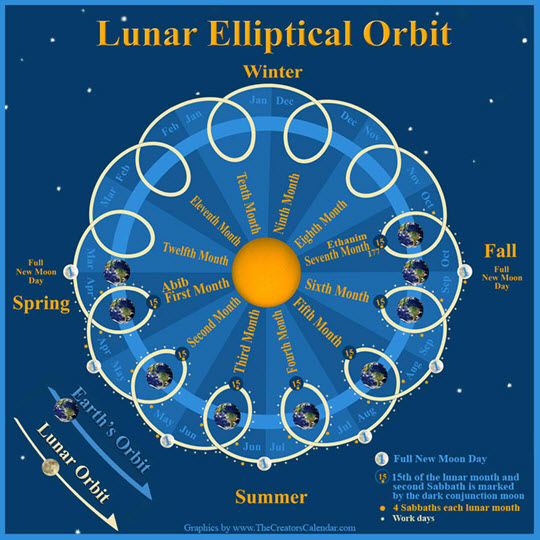 This illustration is from the Heliocentric Model and will be changed in time to reflect the Geocentric Model. The rhythms of time do not change, only the perspective and worldview.
This illustration is from the Heliocentric Model and will be changed in time to reflect the Geocentric Model. The rhythms of time do not change, only the perspective and worldview.
Everyone exalt and restore Yahuah’s Sabbaths, the New Moons and their lunar months, and yearly fixed Feast times. Number them by the ordained measure of the elliptical and perpetual [lunar] face that turns, forming time as was purposed by Yahuah. Guard and protect this sign marker with a posted watch of the place of assembly, as convened for signs, as a token of evidence. Watch over this sacred and dedicated thing as a charge and service by the sons of Aaron, and the others who minister unto the sanctuary of Yahuah. 1 Chronicles 23:30-32 The Creator’s Calendar Restored Text
Lunar Years – According to Genesis 12:1, the loving Father, Yahuah, revealed to Moses that the New Year began in the spring rather than winter. The Creator’s astro- luni-solar calendar year fluctuates from 354 days of a regular year to 384 days of an embolismic year.
luni-solar calendar year fluctuates from 354 days of a regular year to 384 days of an embolismic year.
The sun, moon, and stars, as His time principles that rule in the shamayim (heavens), play the dominant role in proclaiming that the New Year has begun, as defined in Genesis 1:14-18. The recent discovery regarding Revelation 12:1 supports this. Here, it is seen that the constellation Bethula (Virgo), with the full moon under her feet, is the great sign in the shamayim declaring when the New Year begins. The moon under her feet occurs one night only when the moon rises in its complete and conspicuous fullness and shines from east to west the whole night through.
This celestial event harmonizes all the elements necessary for celebrating the Passover and Feast of Unleavened Bread in the correct lunar month when the barley will be ripe. This is because the appearance of Bethula (Virgo) follows the rhythm of the shamayim cycle, setting the sequence of embolismic years to harmonize the lunar months within every 19 solar years.
As a second witness, the barley harvest affirms that a New Year has begun, as it is a necessary element for celebrating this Feast.
Article Link: A Great Sign Appeared in the Shamayim (Revelation 12:1)
M
Meridian – The highest point in the arc of any celestial body.
Metonic 19-Year Cycle – The Metonic 19-year cycle derives its name from the Greek astronomer and mathematician “Meton,” who was acclaimed in his country for its discovery, or he simply made a known fact available to the common folk. Either way, all the nations of the ancient world utilized this 19-year cycle prior to Meton, but under other names. Inherently, this is self-evident because all nations of the Earth utilized the rhythms of the moon to mark the commencement of their years and months.
The yearly lunar cycles fall short of the vital spring Vernal Equinox solar marker by 10-11 days during twelve “regular” years of the 19-year Metonic cycle. Yet, the lunar month cycles were designed by our Creator to proactively take back the lost time during seven embolismic 13-month years within the same 19-year period. This built-in lunar dynamic ultimately restores the lunar cycles back into nearly perfect harmony with the Vernal Equinox at the end of the 19-year Metonic cycle. This leaves a disparity of only minutes to two hours. But then, over a 76-year period of four 19-year cycles, far greater precision is realized.
The point here is that by retaining a consistent and accurate set of solar and lunar attributes, time will never get out of sync over hundreds of years, as do strictly lunar or strictly solar time-measuring models. Strikingly, it is the moon that has the automatic built-in system to restore and synchronize the sun, and the wheel of the stars, with itself.
The keyboard below makes for a perfect example of how the Metonic 19-year cycle yields in their order, the placement of the 12-month lunar years, and the 13-month lunar years.
Not one single unit of time cycles outside our Creator’s astro-luni-solar calendar model. It is only as rebellious mankind has “thought to change TIMES & LAWS” of the Creator by removing the moon from the formula that it has appeared otherwise. But modern methods of time-measuring only cause it to “appear” that the year has always begun in winter, that months vary in length from 28-31 days, and that weeks cycle continually with no connection to the rhythms of any of the trinity of lights in the shamayim (heavens). Additionally, we have all been taught that the days are counted from 1-28, 29, 30, or 31 simply because the Roman Gregorian calendar declares it so. But under the rubble of the dark ages, of a fraudulent replacement calendar system, one can never know what day or week one is in if stranded on a deserted island.
But with the true astro-luni-solar calendar model, there exists a constant reality that the moon will naturally bring its adherents back to number 1 of the cycle, realigning them with the vernal equinox of the solar cycle for years. But additionally, it is self-evident that the “cycle” has existed from the beginning of time, as it has perpetually cohabitated with astro-luni-solar timekeeping. Traditionally, the years 3, 6, 8, 11, 14, 17, and 19 are embolismic years because they each have the added 13th intercalary month in the sequence of the cycle. This cycle is said to be so accurate that it can be used to predict eclipses in addition to forming the basis of the Scriptural astro-luni-solar calendar. It can be illustrated by using a piano keyboard.
The cycle will vary according to the factors utilized, i.e., the choice of New Moon lunar phase and time of the year chosen for it to begin will all affect which year of the cycle you are currently in. Until we find otherwise, it appears this cycle continues to sequence in sync with the full New Moon.
At the end of the day, even the “solar only” Romans have eaten humble pie every year since the fourth century A.D. They discovered that the only way to designate a date for their new replacement holiday of Easter Sunday and never allow it to occur on the true Passover of the Jews whom they hated had to utilize the same luni-solar time-measuring method. But additionally, they had to utilize the 19-year Metonic cycle to achieve the correct orderly rhythm of both the 12-month and 13-month lunar years. This arrangement continues to this day as the greatest testimony that Passover was always located upon the luni-solar calendar, the 14th day as counted from the New Moon.
Mo`ed (mo’edim) – H4150 מועד – This is the Hebrew term that means – appointed fixed-time for the purpose of sacred assemblies. This term appears to be primarily related to the lunar monthly cycle.
Month – A measure of time corresponding to the period of revolution of the moon. Oxford English Dictionary, 1971.
The word month (or Chodesh in Hebrew, see Strong’s #2320) in Scripture specifically means New Moon, which declares that a new astro-luni-solar month will begin the following sunrise. The month commences the day after the night “full” New Moon. This is the night the conspicuous “full” New Moon rises following sunset, shining from the east unto the west all night through.
This is repeated each and every month for twelve (or thirteen) months. The month consists of 29 or 30 days. Six months of every year are 29 days in length, and the other six are 30 days, usually rotating every other month, but not always. The term “month” is eternally connected to the term “New Moon,” as the New Moon is the beacon and first lunar phase defining when a month commences.
Strong’s Expanded Dictionary of the Renewed Covenant (NT) a month — #3376 (18x) men, mane, a primary word; a month:– month Men, connected with mene, “the moon,” akin to a Sanskrit root ma-, “to measure” (the Sanskrit masa denotes both moon and month, cf, e.g., Lat. menses Eng., “moon” and “month,” the moon being in early times the measure of the “month”).
All mention of “months” or “New Moons” in the Renewed Covenant (NT or Brit Chadasha) refer to lunar months:
Month Names – See lunar month
Mosaic Calendar – The calendar established by the Creator and reaffirmed by Him at Mt. Sinai, kept by the Messiah during His life on Earth and used by apostolic Christians until the Council of Nicea.
Mount Zion – #2022 = har + #6726 Tsiyon- This is the mountain of Yahuah’s government, which includes both His astro-luni-solar calendar that alone locates His appointed times and also includes all of His laws, statutes, judgments, and feasts. All of these are found in the Torah Law and the Testimony of the Sanctuary ceremonies. Together these tell the time-centric story of salvation to be accomplished by the Messiah alone.
Strong’s Concordance – Mountain – #2022 = har – mountain (literal or figurative) – Figurative system of government, which includes both time reckoning of any single government and its laws.
ZION ir jordan 11 bred game worn 1996 finals auctio
“Beautiful for situation, the joy of the whole earth, is Mount Zion, on the sides of the north, the city (H#7151קרית – proclamation or city) of the great King.” Psalms 48:2
“The ways of Zion do mourn, because none come to the solemn feasts: all her gates are desolate: her priests sigh, her virgins are afflicted, and she is in bitterness.” Lamentations 1:4
“Blow the trumpet in Zion, and sound an alarm in my holy mountain: let all the inhabitants of the land tremble: for the day of YAHUAH comes, for it is near at hand . . .” Joel 2:1
“Rejoice greatly, O daughter of Zion; shout, O daughter of Jerusalem: behold, your King comes unto thee: he is just, and having salvation; lowly, and riding upon an ass, and upon a colt the foal of an ass.” Zechariah 9:9
N
New Moon – The Hebrew term is Chodesh H2320 חדשׁ. This is the first lunar phase of a lunar month, as witnessed in the night sky.
New Moon Day – After much research it has been discovered that the Creator’s original New Moon is the full moon. This unpopular view is supported by the weight of evidence found in Scripture (see table and links below). This event actually occurs at sunrise when the first rays of the sun, together with the full moon, are both visible above the eastern and western horizons at the same time. During that previous night, the full moon rose from the eastern horizon near sunset and made its way across the entire night sky, announcing two things, first that this was to be the last night of the previous month and that the New Moon (new month) would commence at sunrise.
In the Tanakh Strong’s (# 2320 – Chodesh), the New Moon, by implication, is a month; monthly. From its root word (#2320 – Chadesh) to be new; to rebuild; [rebuilt]; renew and [renewed]. In the Renewed Covenant, this full moon lunar phase is referred to as (Selene #4582), meaning brilliant moon, and (teleios #5046), meaning perfect, complete, fully developed).
Additional Scriptural Support for the “Full” New Moon
Presented below is a growing list of diverse Scriptural supportive evidence for the Full New Moon. Each of the following studies is outlined in their order as they build upon one another. Simply click on each link below.
- Luke 23:44-45 – The Sun was Darkened From the Sixth to the Ninth Hour. According to Luke, a solar eclipse occurred on the day of the Messiah’s crucifixion between the sixth and the ninth hour. This was a fulfillment of the prophecy of Amos. This can only happen during the dark conjunction lunar phase, revealing the true New Moon is the “full moon.”
- Amos 8:9-11 – Amos Prophesied a Darkened Sun to Occur at the Messiah’s Death. This Tanakh prophecy given 800 years prior to the crucifixion declares a solar eclipse was to occur at noon on the day of the Messiah’s death. Three Renewed Covenant writers confirm this as fact. A solar eclipse occurs only at the time of a dark lunar phase, as a result the evidence supports the “full moon” as the true New Moon.
- Matthew 24:27 – All Ruling Luminaries Shine from the East unto the West. Each shamayim luminary shines from east to west when it is both visible and ruling time. The only lunar phase that does this is the “full moon,” making it the true new moon of Scripture and the temple services.
- Job 26:9 – He Apportions the Face of the Full Moon. The Creator apportioned and formed time on the face that declines and turns back to the “full moon” as the seat of authority, distinctly separating it according to its covering, as an ordained statute of set time.
- Revelation 22:2 – The Tree of Life is Regulated by the New Moon. Did you know there is a moon in the New Jerusalem, the sacred city above? The tree of life yields twelve fruit, one each month according to the measure of the New Moon.
- Revelation 21:21 – Twelve Gates are Twelve Pearls. The twelve gates of the New Jerusalem are twelve whole, individual pearls, representing twelve “full” New Moons.
- Psalms 118:18-24 – The Open Gate and the Stone Rejected are Symbols of the Full Moon. The open gate and the stone rejected are related terms to the work of the “full moon,” which itself is a symbol of the Messiah, “the light of the world.”
- Revelation 12:1 – A Great Sign Appeared in the Shamayim Announcing New Year’s Day. Discover that the great sign in the heavens of the woman clothed with the sun depicts a full moon under her feet, with twelve constellations symbolized above her head. Remarkably, this image is revealed in the shamayim one time each year, occurring only on New Year’s Eve in the spring of the northern hemisphere.
- Psalms 81:3 – Blow the New Moon Shofar on the Full Moon. Blow the New Moon shofar on the “full moon,” the processor of time for all the holy Feasts (chag).
- Hosea 2:11 – I Will Cause Your Mirth to Cease on “Chag.” Reveals that “chag” can represent one feast or seven, not simply the pilgrim feasts occurring on the 15th, as a result neither the term “chag” nor the “full moon” can be fastened to the middle of the lunar month.
- James 1:17-18 – Yahuah is the Father of Lights. Discover which lunar phase is the only lunar phase that can represent the Father of lights with no shadow from its turning orbit in it.
- Proverbs 4:18-23 – The Pathway of the Righteous as a Start and Finish Line. This study illustrates the pure and perfect light of the “full moon” is metaphorically represented as the finish line for the righteous seeker of truth. As the light of this lunar phase has come full circle, might it also be the starting point, as in the New Moon?
- Psalms 89:35-37 – The Full Moon is “First” Among the Lunar Phases. This study reveals that the full moon is “first” among the lunar phases and is set apart for sacred use in the appointed times of the Sanctuary. As a result of this “new light” the call can be heard: “Babylon is fallen, is fallen . . . come out of her my people, lest you share in her sins, and lest you receive of her plagues.”
- Genesis 15:12, 17 – The Night was Dark 430 Years Prior to the Exodus to the Very Day. Yahuah’s Covenant with Abraham was made on a night identified as “dark.” This “dark” night is the foundation for identifying the correct time of the month for Israel’s miraculous Exodus from Egypt 430 years later to the very day and by implication, the true New Moon.
The New Moon day is day one of each lunar month and never a seventh-day Sabbath or a workday (Ezekiel 46:1). The moon is a trustworthy witness because it never lies, as it is Yahuah’s sacred time signal for all appointed Feast days, including the seventh-day Sabbath (Leviticus 23:1-4).
According to Leviticus 23:24-25, the Feast of Trumpets in the seventh month is the only Feast Sabbath that occurs on a New Moon day. New Moon days are never included in the Feast Count of Shabuoth because they are not part of the Sabbaths Complete equation. (See Sabbaths Complete)
The belief that the dark occulted lunar phase of the moon, known as a conjunction, is the New Moon is not in harmony with Yahuah’s principle of light as it relates to truth. The conjunction phase is not a visible orchestrated system that beacons light. No aspect of the moon can be seen, or its time measured at the dark conjunction lunar phase.
Historically, a signal or beacon has always been synonymous with light and NEVER with darkness. Therefore to be the light of the world or the light of truth, a perfect representation of the Messiah and Savior, it must be visible and an orchestrated dual-action manifestation of both the sun and the moon. Yahuah has never used any portion of darkness to represent His truths, thus making the teaching that the dark conjunction lunar phase is the New Moon a self-evident error.
Ye are all the children of light, and the children of the day: we are not of the night, nor of darkness. 1 Thessalonians 5:5
Blow the trumpet at the time of the New Moon, at the full moon, on our solemn feast day. For this is a statute for Israel, A law of the God of Jacob. Psalms 81:3-4
Also, see “Month” for comparison.
Night – Night is the period of a calendar date that occupies the darkness. It is defined in Genesis 1:14-18 as being ruled by both the moon and the stars. The stars commence their shining at precisely sunset and shine until precisely sunrise. The night is never included in the “day,” as clarified in Genesis 1:4-5, where the Creator separated the light from the darkness and called the light “day,” and the darkness he called “night”. . . What our Creator separates, we are not to put back together.
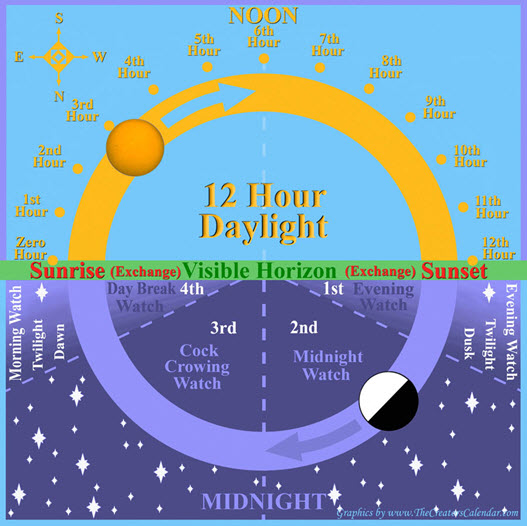 The night is not reckoned by hours, as is the daylight but by Four Watches.
The night is not reckoned by hours, as is the daylight but by Four Watches.
Night Watches – The night watches are not divided into four equal lengths of time; rather, each “watch of the night” is defined by the parameters of the unique features of the night. In the Tanakh, only three watches can be identified, but that is not to say there are four. From the words of our Messiah himself, as recorded in Mark 13:35, we find the following four.
- First watch: The evening watch commences at sunset and occupies the time known as dusk, evening or twilight, in keeping with its name.
- Second watch: The Midnight Watch commences at full darkness and ends at midnight, in keeping with its name.
- Third watch: The Cock Crowing commences at precisely midnight and ends at first light of dawn, this is when the rooster begins to crow, thus it is in keeping with its name.
- Fourth watch: The Morning Watch or Daybreak Watch commences at the time the Rooster begins to crow, occupying the period known as dawn. According to Hebrew, dawn and the Fourth Watch of the night are synonymous. The “Morning Watch” title defines it as the portion of time of watching for the full radiant beams of sunrise.
Nisan – This is a Babylonian name that, for the most part, correlates with the Hebrew Month of Abib (Exodus 12:1-2), which is the first lunar month of the astro-luni-solar calendar commencing in spring.
It commences as a one-night event each spring, marked by the full New Moon arising beneath Bethula’s (Virgo) feet and shining from east to west the whole night through (Revelation 12:1). The first full day of this month is the Scriptural New Year’s day (Exodus 12:1-2). The barley became ripe for the Wave Sheaf Offering.
Article Link: A Great Sign Appeared in the Heavens (Revelation 12:1)
O
Opposition—When the moon is in opposition to the sun, it is the moment of the full moon. Usually, on the following sunrise, it is visually evident that the moon has crossed the line of opposition because it is
the first day that both the sun and moon can be seen together on opposite horizons in the morning sky. Thus New Moon Day has begun.
P
Passover, Feast of – Annual Rehearsal of the Prophetic Lamb Slain for Sin – Leviticus 23:5
The Feast of Passover is one of two solemn yearly Feasts (Holy Days). This Feast was to have a dual application in that it was a memorial of the dark night Yahuah passed over Israel and killed all the firstborns in Egypt. All of Israel had been sp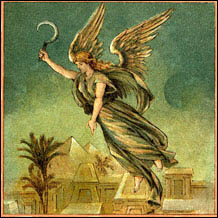 ared that night because they had obediently placed the blood of the lamb, representing the promised Messiah, on their doorpost. In this way, the connection was made connecting Passover to the prophecy of the Messiah who was to die for the sins of the whole world, and thus represents the earth’s darkest hour. Traditionally, prior to the coming of the Messiah, the Passover Lamb was to be slain and eaten that night.
ared that night because they had obediently placed the blood of the lamb, representing the promised Messiah, on their doorpost. In this way, the connection was made connecting Passover to the prophecy of the Messiah who was to die for the sins of the whole world, and thus represents the earth’s darkest hour. Traditionally, prior to the coming of the Messiah, the Passover Lamb was to be slain and eaten that night.
It must be a perfect he lamb of a year. You may take it from the sheep or from the goats; and you must keep it by you until the fourteenth day of this month, then kill it. All the assembly of the families of Israel must kill it between the dusks (dawn and twilight). Then they shall take of the blood and sprinkle upon the two door-posts, and upon the lintel of the houses where they eat it. And they shall eat the flesh in that night, roasted with fire. Exodus 12:5-8 Ferrar Fenton Version
Therefore it appears that they sacrificed the Passover on the fourteenth day of the month between morning and evening, placing the blood on the door posts and lintel and then ate it after sunset in the Wilderness of Sinai. (Numbers 9:5)
Passover is the first appointed annual feast of the year and is always in the spring. According to Exodus 12 and Leviticus 23, it is always on the 14th day of the first month of Abib, counting from the full New Moon day. It is always the 6th day of the week, also known as the preparation day. It is always on or very near the dark moon lunar phase. (Luke 23:44-45) The day following Passover is always the seventh-day Sabbath, which is also always a High Sabbath because it is the first day of the Feast of Unleavened Bread. The Hebrew Tanakh and Greek Renewed Covenant never refer to Passover as Friday because Friday not only did not exist then, but if it had, it would not have been in sync with the astro-luni-solar calendar of the temple service. Passover is the first of the appointed feasts, which the Messiah fulfilled precisely.
These are the feasts of Yahuah, sacred convocations which you shall proclaim at their appointed times. On the fourteenth day of the first month at twilight is Yahuah’s Passover. Leviticus 23:4-6
Perigee – “That point in the orbit of a celestial body, especially of the moon, in which it is at its closest proximity to the earth: opposed to apogee, which is at its furthest distance.” The moon in perigee appears largest because it is nearest the earth. Perigee is the opposite of Apogee. See Apogee.
Phase, Phases, Phasis – In astronomy, these represent any stages or variations in the illumination or appearance of the moon or a planet.
Planetary Day Designation – Planetary names are applied to the days of the seven-day week that cycle without end. It should be noted that the oldest dated Christian inscription to employ such a planetary designation belongs to the year 269 A.D. (Inscriptiones Christianae urbis Romae, ed. De Rossi, 1861, i, No. 1).
This ordination of names is just another example of pagan titles designating artificial units of time.
Prophecy – History that is divinely appointed in advance.
Prophet – The standard of a true prophet is outlined in Scripture. Any person declared a prophet of the Most High, must perfectly meet this standard, or they do not qualify as a prophet under any circumstances. This requires the absolute honesty of each individual to check the entire history of one who has been determined to be a prophet.
- Yahuah will speak to them in dreams, visions, and to some face to face (Numbers 12:6).
- The prophet will give signs and wonders that always come to pass (Deuteronomy 13:1).
- If the signs and wonders come to pass, but the professed prophet teaches you to worship false gods, and break the commandments, then he/she is not a true prophet (Deuteronomy 13:1).
- Yahuah will put the words in the prophets mouth, the prophet will not have to glean the thoughts or words from other sources (Deuteronomy 18:18).
- If a prophet presumes to speak a word in My name, which I have not commanded him to speak, or speaks in the name of other gods, that prophet shall die. (Deuteronomy 18:20).
- When the prophet speaks in the name of Yahuah and that thing does not happen, or come to pass, then it was not from Yahuah. So do not listen to this professed prophet (Deuteronomy 18:22).
- “Therefore behold, I am against the prophets,” says Yahuah, “who steal My words every one from his neighbor.
- Behold, I am against the prophets,” says Yahuah, “who use their tongues and say, ‘He says.’
- “Behold, I am against those who prophesy false dreams,” says Yahuah, “and tell them, and cause My people to err by their lies and by their recklessness. Yet I did not send them or command them; therefore they shall not profit this people at all,” says Yahuah. Jeremiah 23:30-32 NKJV
Recommend Book Link: Life of Ellen White
Q
Quartodecimen – Catholic Encyclopedia also Old Testament Christian View of the Law. Eusebius of Caesarea History Eccl., V. xxiii) wrote:
“Fourteenism” is derived from Latin and refers to the practice of fixing the celebration of Passover for Christians on the fourteenth day of Nisan in the Old Testament’s Hebrew Calendar (for example, in Latin, “quarta decima”). This was the original method of fixing the date of the Passover, which is to be a “perpetual ordinance.”
A letter from St. Irenaeus shows that the diversity of practice regarding Easter had existed at least from the time of Pope Sixtus I (c. 120). Further, Irenaeus states that St. Polycarp, who like the other Eastern Christians, kept Easter on the fourteenth day of the moon . . . following therein the tradition, which he claimed to have derived from St. John the Apostle.
About 195, Pope Victor I excommunicated the Quartodecimens. Though this was regarded as immoderate – Origen in the “Philosophumena” (VIII, xviii) seems to regard them as a mere handful of wrong-headed nonconformists – the practice (by the Jews & Christians of keeping Passover by the lunar calendar Nissan 14) was forced underground.
R
S
Sabbath – The divinely appointed day of rest, occurring every seventh day following each “full” New Moon. There are precisely four seventh-day Sabbaths every lunar month, which consistently fall upon the lunar calendar dates of the 8th, 15th, 22nd, and 29th.
Sabbath and New Moon (Rosh Hodesh) both periodically recur in the course of the year.
The New Moon is still, and the Sabbath originally was, dependent upon the lunar cycle. Universal Jewish Encyclopedia, p. 410.
The connection of the Sabbath with lunar phases, however, was (later) discarded by the Israelites . . .The New Schaff-Herzog Religious Encyclopedia, p. 135-136.
Yeshua [Yahusha the Messiah]…observed a Sabbath, but this Sabbath was neither Saturday nor Sunday. The Nazarene Sabbath was a lunar Sabbath . . . of the lunar month. (A lunar month starts on the New Moon). This was standard practice among the Beni-Aumen Nazarene Order and most of the other orthodox Jewish sects of the time…Lunar Sabbath observance is an ancient Semitic custom concurrent and ante-dating the time of Yeshua . . .” (ibid.). Shawui Sabbath: Ancient Sabbath Observance
Sabbaths Complete – Six workdays plus one seventh-day Sabbath equals one Sabbath Complete. This was the template that Yahuah ordained at Creation. These will never include New Moon days or translation days because they are not the days specified in the equation. Yahuah uses Sabbaths complete to punctuate that the same sacred astro-luni-solar calendar reckons His ordained week and seventh-day Sabbath as all the yearly appointed Feast Days. This is demonstrated and clarified by His Sabbaths Complete being fixed simultaneously on both the date of the month counting from the New Moon to locate the Feast of Unleavened Bread on the 15th day. The first day of this feast is always the 15th day which is also always a seventh-day Sabbath. Therefore the anchor markers are simultaneously fixed on both the dates of the month as well as within the days of the week, each month without variation, as well as each and every year. Again, this cannot be accomplished using the Gregorian calendar.
And you shall number to you from the day after the Sabbath, from the day you bring in the sheaf of the wave offering, seven Sabbaths perfect [complete, KJV] they shall be, to the day after the Sabbath seventh; you shall number fifty days. Leviticus 23:15, 16 (The Interlinear Bible: Hebrew, Greek, and English.)
Sacred Days – These are the divinely ordained days for “worshiping” our Creator, Yahuah, within the boundaries of His astro-luni-solar time system. These sacred days include New Moon days, seventh-day Sabbaths, and all the annual set-apart feast days as recorded in Leviticus 23. All New Moon days are defined as worship days in Scripture.
Likewise the people of the land shall worship at the entrance to this gateway before Yahuah on the Sabbaths and the New Moons. Ezekiel 46:3-4 NKJV
Below is an example of Israel complaining, desiring that both the New Moon and the Sabbath must be passed before they can resume their industry of buying and selling.
When will the New Moon be past that we may sell grain? And the Sabbath, that we may trade wheat? Amos 8:5 NKJV
For the other set-apart days, see Feast Days.
Seasons – (#4150 מועד or מועדה) mo’edim, mo`ed, or mo`edah, properly an appointment, i.e. a fixed time or season; specifically, a festival; conventional a year; by implication, an assembly (as convened for a definite purpose); technically the congregation; by extension, the place of meeting; also a signal (as appointed beforehand): appointed (sign, time), (place of, solemn) assembly, congregation, (set, solemn) feast, (appointed, due) season, solemnity, synagogue, (set) time (appointed).
Shamayim – Hebrew plural term for the heavens; the visible time measuring mechanism of the sun, moon, and stars.
Shebat – This is the only name recorded in Scripture for the eleventh lunar month of the astro-luni-solar calendar. This word appears to originate in Babylon (Zechariah 1:7).
Signs of the Times – Divinely appointed lunar feast days designed by the loving Father depict the specific work/ministry of Yahusha, the Messiah, in the shamayim Sanctuary. This work of the Renewed Covenant’s end result is to write His laws on our hearts rather than on mere stone, as was the case with the Old Covenant. Each feast or “Sign of His Times” is time-centric to the lunar-solar calendar and is to be fulfilled on its exact calendar date. These include from the past Passover, Feast of Unleavened Bread, the Wave Sheaf offering, and Pentecost, and from the future are the Feast of Trumpets, Day of Atonement, Feast of Tabernacles, and the Seventh-day Sabbath and New Moon days. According to the Sanctuary model, the second coming of our Savior and Redeemer will be a physical and visual manifestation that will occur on the 15th of Ethanim, the seventh lunar month of a year yet future.
Sin – The name of the Babylonian Crescent 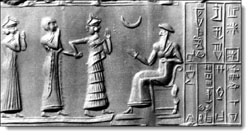 Moon God, also recognized as the crescent of Islam.
Moon God, also recognized as the crescent of Islam.
Sin – The transgression (breaking) of the law of Yahuah. Romans 4:15; 1 John 3:4
Sin is the same in both the Tanakh and Renewed Covenant (Brit Chadasha). The difference is in how it is removed from our lives. In the Tanakh, under the Old Covenant, the system designed by our loving Father was made through the present daily and yearly work of the High Kohen in the earthly temple system. But at the cross of the Messiah, it all changed. No longer was there a need for the blood of bulls and goats, for our Messiah and Savior himself became our sacrifice for sin. But it did not end here; rather, this was only the first step in a seven-part series of ministerial phases He was to procure for mankind as a part of the full restoration.
What began at the cross under the title of the New Covenant was the prophetic fulfillment of our Messiah working out our Salvation, but with our obedient participation through humility and confession of sin. It was essential to keep this focus before mankind, so they can follow his work as our eternal Lamb and High Kohen whithersoever He goes in the courts above. This is why He gave us His feast days. These are our days of participation so that we may humbly honor and worship Him in Ruach (spirit) and truth.
Sivan – This is the only name recorded in Scripture for the third lunar month of the astro-luni-solar year (Esther 8:9). It appears to be derived from Babylon.
Sosigenes – an Alexandrian astronomer who advised Julius Caesar about the reform of the calendar, and Sosigenes decided that the only practical step was to abandon the lunar calendar altogether. According to his council, months must be arranged on a seasonal basis, and a tropical (solar) year must be used, as in the Egyptian calendar. “The Julian Calendar,” Encyclopedia Britannica.
Syzygy – The straight-line, or nearly straight-line configuration of three celestial bodies (as the sun, moon, and earth during a solar or lunar eclipse) in a gravitational system. Merriam-Webster’s Collegiate Dictionary
T
Tabernacles, Feast of – it is clearly stated in Leviticus 23:34 that the fall Feast of Tabernacles is a seven-day feast, not an eight-day feast as some have supposed (Leviticus 23:39-43).
This Festival commenced on the 15th day of the Seventh Month, also called Ethanim, counting from the “full” New Moon, and ends on the 21st day. Because the first day of this festival begins on a seventh-day Sabbath, it is also a High Sabbath. By clarifying that the following eighth day was also a seventh-day Sabbath, Yahuah punctuated that His sacred astro-luni-solar calendar system reckons His ordained week and seventh-day Sabbath. This is demonstrated and clarified by this full-week festival being fixed simultaneously on both the date of the astro-luni-solar month counting from the New Moon, as well as fixed within the days of the week, each and every year. This Festival of Tabernacles cannot be located correctly on any other form of calendar other than the calendar of Divine origin. It is here demonstrated that the Creator did not author the unbroken cycles of successive weeks, as they can never be in harmony with the criteria given.
Tammuz – This is the name of a pagan god. It is a Babylonian name for the fourth lunar month of the astro-luni-solar calendar. Tammuz is not used in the Scripture as a title for a month.
Tebeth – This is the only name recorded in Scripture for the tenth lunar month of the astro-luni-solar calendar. This name appears to originate in Babylon and is only recorded once in the book of Esther (Esther 2:26).
Three Kinds of Days each Lunar Month – From the book of Genesis, we find discover that there are two kinds of days each week – 1) workdays and 2) seventh-day Sabbaths. But from the remainder of Scripture, we discover that indeed there are three kinds of days each lunar month – 1) New Moon Days, 2) workdays, and 3) seventh-day Sabbaths.
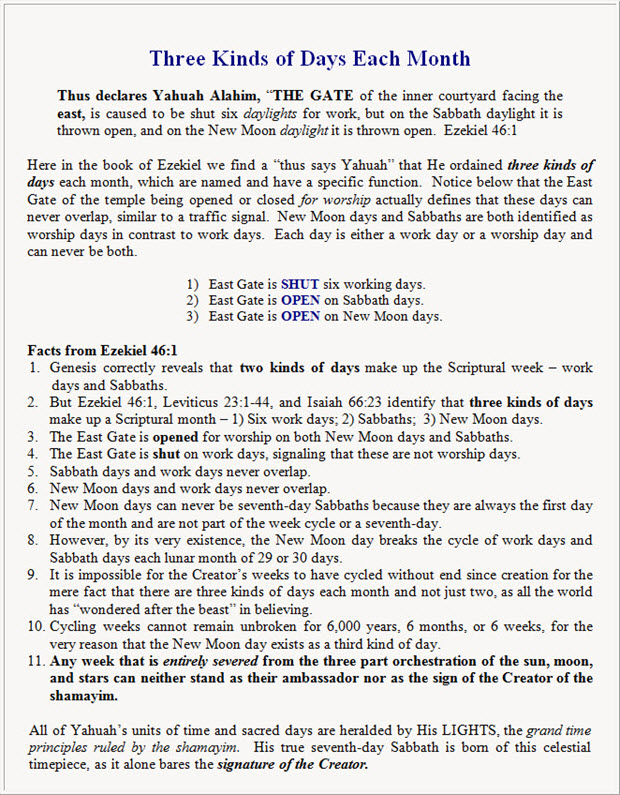 Translation Day – This title is purely an astronomical term and is not referenced in Scripture. It is the period of time between conjunction and the first appearance of the New Moon. It is the 30th day of the month, which lies between the seventh-day Sabbath on the 29th and the New Moon of the following month. This 30th day known as Translation Day, never ever affects the lineup of lunar Sabbaths. This is because it follows the last Sabbath of any given month and then is followed by New Moon day, which beacons the new month and refreshes the new cycle of four weeks and their respective Sabbaths.
Translation Day – This title is purely an astronomical term and is not referenced in Scripture. It is the period of time between conjunction and the first appearance of the New Moon. It is the 30th day of the month, which lies between the seventh-day Sabbath on the 29th and the New Moon of the following month. This 30th day known as Translation Day, never ever affects the lineup of lunar Sabbaths. This is because it follows the last Sabbath of any given month and then is followed by New Moon day, which beacons the new month and refreshes the new cycle of four weeks and their respective Sabbaths.
There are only three kinds of days defined in Scripture. While the sun rises and sets on Translation Day exactly as it does on all other days, it is unique in its purpose, as it occurs approximately six times every year. This day can never be either a seventh-day Sabbath or a New Moon day; however, it appears to be a mere workday. It is always the day following the fourth Sabbath of the month when the month is 30 days long. On the 29-day months, New Moon Day follows the fourth Sabbath of the month. It is my current belief that Translation days are not included in the Count to Feast of Weeks (Feast of Shabuoth or Pentecost) because they are not part of a consecutive set of six workdays followed by the seventh-day Sabbath, which is the Scriptural criteria required for a “week” and for a Sabbath Complete.
The importance of this day lies in keeping the days of the 12-month years totaling 354 days and the days of the thirteen-month years totaling 384. This day is invaluable in bringing into harmony the Creator’s astro-luni-solar year with the solar year every 19 years.
Trumpets, Feast of (Yom Teruah) – In the seventh month, on the first day of the month, you shall have a Sabbath rest, a memorial of the blowing of trumpets, and a sacred convocation. Leviticus 23:24
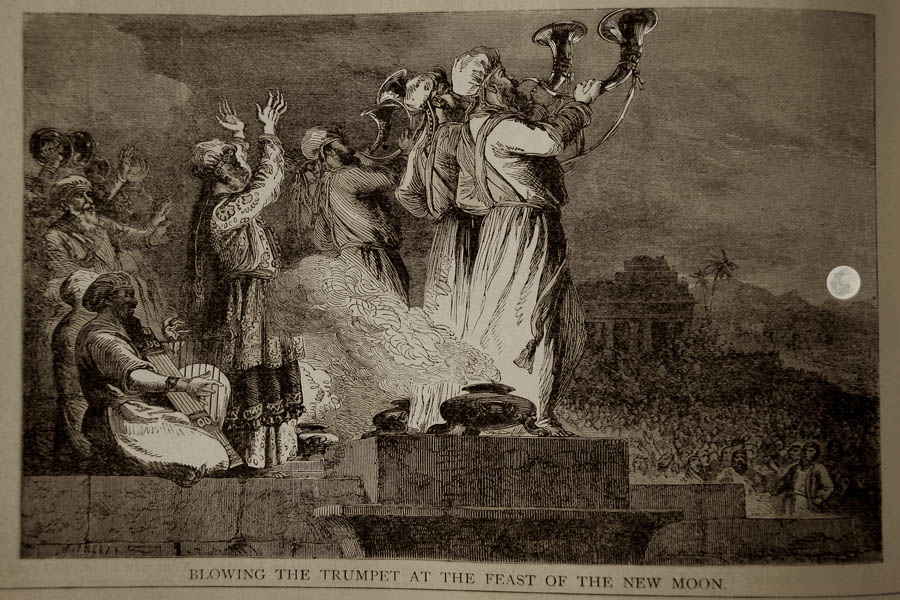 The Festival of Trumpets always begins on the “full” New Moon day of the month of Ethanim/Tishrei, which is the seventh month of the Scriptural Hebrew year. The name of the feast itself identifies it as announcing or trumpeting a coming important event. In this case, as in the typical yearly sanctuary service, it is announcing the coming final judgment, the “Day of Atonement.” Perhaps the last Feast of Trumpets will be the literal fulfillment of when the great trumpet shall blast from the shamayim, where Yahusha the Messiah announces the day and hour of His coming. While the Festival of Trumpets is only a one-day feast, it commences the ten-day count down to the solemn feast Day of Atonement. These days are best utilized in surrendering our hearts and minds to Yahuah. Confessing sin and asking for His loving and compassionate forgiveness. Some focus their attention on one of the Ten Commandments for each day of the countdown. In this way, they have not left any moral stone unturned in preparation for the coming symbolic great Judgment Day.
The Festival of Trumpets always begins on the “full” New Moon day of the month of Ethanim/Tishrei, which is the seventh month of the Scriptural Hebrew year. The name of the feast itself identifies it as announcing or trumpeting a coming important event. In this case, as in the typical yearly sanctuary service, it is announcing the coming final judgment, the “Day of Atonement.” Perhaps the last Feast of Trumpets will be the literal fulfillment of when the great trumpet shall blast from the shamayim, where Yahusha the Messiah announces the day and hour of His coming. While the Festival of Trumpets is only a one-day feast, it commences the ten-day count down to the solemn feast Day of Atonement. These days are best utilized in surrendering our hearts and minds to Yahuah. Confessing sin and asking for His loving and compassionate forgiveness. Some focus their attention on one of the Ten Commandments for each day of the countdown. In this way, they have not left any moral stone unturned in preparation for the coming symbolic great Judgment Day.
U
Unleavened Bread, Feast of – Annual Rehearsal of the Prophetic Bread of Life – His Life for Ours – Leviticus 23:6-8
The spring Feast of Unleavened Bread begins on the 15th day of the first month of Abib, counting from the New Moon. It begins at the moment Passover comes to an end at sunrise. This second feast commences on a seventh-day Sabbath, making the first day of this seven-day feast a “High Sabbath” each and every year. This feast ends on the sixth day of the week, the 21st day of the month, which is also appointed as a holy convocation or Sabbath, which can never be a seventh-day Sabbath. Then the day following the 21st is the seventh-day Sabbath, also a sacred convocation, which makes the 21st and 22nd back-to-back Sabbaths or sacred convocations each and every year. There is no variation when the Feast of Unleavened Bread begins or ends because it is fixed not only to a specific date, the 15th of the month counting from the New Moon but also within specific and fixed days of the week, each and every year.
This is another one of the Creator’s true and paramount calendar definers. This is because this shows that the weeks of Scripture and Yahuah have never cycled as an unbroken chain of successive weeks since creation, but that the week and seventh-day Sabbath are also defined by the astro-luni-solar calendar as are all the sacred and set-apart annual feast days. Using the Scriptural criteria, it is simply impossible to pinpoint this Festival of Unleavened Bread, which has both a fixed monthly date as well as fixed days of the week on the Gregorian calendar, where the weeks’ cycle without end in an unbroken chain.
And on the fifteenth day of the same month is the Feast of Unleavened Bread to Yahuah; seven days you must eat unleavened bread. On the first day you shall have a sacred convocation; you shall do no customary work on it. But you shall offer an offering made by fire to Yahuah for seven days. The seventh day shall be a sacred convocation; you shall do no customary work on it. Leviticus 23:6-8
Taking this thought one step further- In this article, it has been established that both the spring Feast of Unleavened Bread and the fall Feast of Tabernacles commence on a seventh-day Sabbath. Using only a Gregorian calendar, try connecting the 15th of any spring month to the 15th of any fall month, where both dates fall on the seventh-day Sabbath. With this simple test is seen that the unbroken cycle of successive weeks cannot remain in harmony with the Creator’s Scriptural calendar for even six months. Refer to the article, Passover to Tabernacles Calendar Challenge.
V
Vernal Equinox –
The Vernal Equinox, otherwise known as the spring equinox, officially falls between the Roman Gregorian solar calendar 03-19 and 03-20 on any given year. This is the astronomical time when the sun crosses the equator, making day and night everywhere on Earth of equal length. Below is a chart illustrating the dates of the Vernal Equinox for the next 26 years, should time last that long. The red check marks highlight the intermittent years that the Vernal Equinox occurs on 03-19.
W
Waning – The lunar phases depicted following the conspicuous full New Moon and including the dark conjunction phase. To visibly decrease in size, extent, or degree: dwindle, as in phase or intensity- used chiefly of the moon. To become less brilliant or powerful – dim. It means to fall gradually from power, prosperity, or influence and to move toward extinction.
Waxing – To visibly increase. To increase in size, numbers, strength, prosperity, or intensity. To grow in volume or duration. To grow toward full development. To increase in phase or intensity – used chiefly of the moon. The waxing phases reach their complete expression in the full New Moon. It is then considered renewed and rebuilt.
Week – As recorded in Genesis 1. Scriptural two kinds of days astro-luni-solar make up the lunar week, six workdays followed by a seventh-day Sabbath. There are never more or fewer days in the Creator’s divinely appointed week. His week will never contain either a New Moon day or a Translation day, as both of these days are not listed in the criteria that make up a week. If Genesis were the only reference to time in the Scripture, we would be right to believe the week was designed to cycle without end. However, taking into account the entire breadth of Scripture, we get a much fuller understanding of weeks as they relate to the preordained cycle of the monthly lunar phases. It is demonstrated in Ezekiel 46:1, Isaiah 66:23, and Leviticus 23:1-39, months are made up of three kinds of days. It is because the New Moon day exists as the third kind of day that causes the weekly cycle to commence and terminate within its framework. If you use a calendar that demonstrates the New Moon floating through the months and landing on either a weekday or a seventh-day Sabbath, you can be sure you are not using the Creator’s Scriptural calendar. Because Ezekiel 46:1 identifies that both the New Moon (day one) and the seventh-day Sabbaths each month are to be kept as sacred set-apart worship days. All other days are workdays that can never overlap with a holy day. It is this verse that keeps us accountable to our Creator’s sacred calendar system, pointing out that His week is indeed the fruit of the sun, moon, and stars, as its reality is counted from the New Moon.

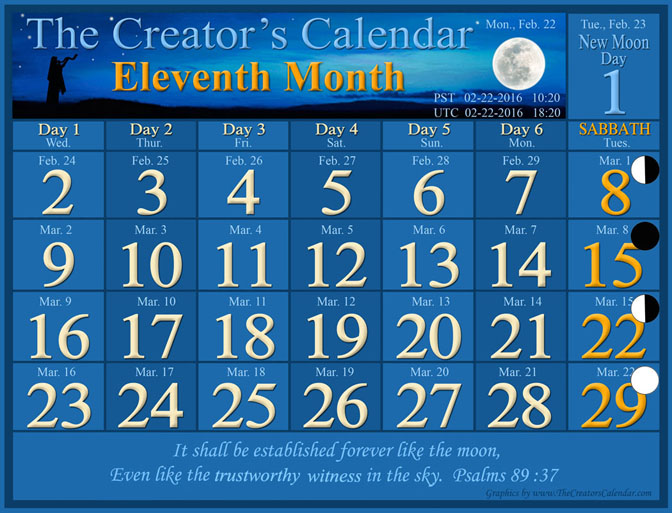 Each full New Moon Day is followed by four successive weeks. These are exhibited by the moon’s waxing and waning phases as it reflects the light of the sun, in addition to its location in the night sky. The following day of each month is the first day of the week. Each week of seven days ends with the Sabbath on the specific dates of the 8th, 15th, 22nd, or 29th day as counted from New Moon, each and every month. In our Creator’s wisdom, He appointed and “set” His three-part orchestrated time-keeping clock on the fourth day of creation, prior to any possible human intervention. According to Genesis 1:14-18 Yahuah divinely appointed the sun, moon, and stars to measure time. The sun was to rule by day, and the moon and stars to rule by night?
Each full New Moon Day is followed by four successive weeks. These are exhibited by the moon’s waxing and waning phases as it reflects the light of the sun, in addition to its location in the night sky. The following day of each month is the first day of the week. Each week of seven days ends with the Sabbath on the specific dates of the 8th, 15th, 22nd, or 29th day as counted from New Moon, each and every month. In our Creator’s wisdom, He appointed and “set” His three-part orchestrated time-keeping clock on the fourth day of creation, prior to any possible human intervention. According to Genesis 1:14-18 Yahuah divinely appointed the sun, moon, and stars to measure time. The sun was to rule by day, and the moon and stars to rule by night?
It is the astro-luni-solar Sabbath that is defined by the three-part orchestration of the sun, moon, and stars that is the true evidence that Yahuah is the Creator of the shamayim and earth, and not an unbroken chain of successive weeks, as we have been led to believe?
Week (Modern continuous seven-day cycle) – The modern seven-day week came into use during the early imperial period, after the Julian calendar came into effect, apparently stimulated by immigration from the Roman East. For a while, it coexisted alongside the old 8-day nundinal cycle, and fasti is known, which shows both cycles. It was finally given official status by Constantine in 321. Roman Calendar Encyclopedia, Days of the Week
“The invention of the continuous week was therefore one of the most significant breakthroughs in human beings’ attempts to break away from being prisoners of nature [and from under God’s law] and create a social world of their own.” The Seven Day Circle: The History and Meaning of the Week, Eviator Zerubavel, New York: The Free Press, 1985. p.11.
“The Babylonians, at a very early period, divided their months into seven-day cycles, of which the last would contain more than seven days, since there are more than twenty-eight days in a lunar month.” Ancient History, Hutton Webster, p. 20.
“The Sabbath depending, in Israel’s nomadic period, upon the observation of the phases of the moon, it could not, accordingly be a fixed day [on a cycling week]. The Jewish Encyclopedia: A Descriptive Record of the History. Edited by Isidore Singer, Cyrus Adler. Volume 10, p. 590. [Emphasis mine]
“Most theologians and some scholars assume that mainstream Jewish society, at the time of Jesus…was practicing a fixed seven-day week which was the same as the modern fixed [cycling planetary designations] seven-day week. This is extremely doubtful. The change, from a lunar to a fixed week, was brought about by the power and influence of Rome. As long as the Nazarenes held power in Jerusalem, all Roman practices and customs, including that of the consecutive week, were held at bay.” Shawui Sabbath: Ancient Sabbath Observance [Emphasis mine]
“These imported [from Babylon] superstitions eventually led Jewish rabbis to call Saturn Shabbti, ‘the star of the Sabbath.’ [and] it was not until the first century of our era, when the planetary week had become an established institution, that the Jewish Sabbath seems always to have corresponded to Saturn’s Day [Saturday].” Rest Days, p.244 by Hutton Webster [Emphasis mine]
“. . . the Jewish festivals being regulated solely by the moon, may fall on any day of the [Roman] week.” Oxford English Dictionary, 1971 Edition, Vol. 2, “Pentecost.” [Emphasis mine]
“The connection of the Sabbath with lunar phases, however, was (later) discarded by the Israelites . . .” The New Schaff-Herzog Religious Encyclopedia, p. 135-136. [Emphasis mine]
Weeks, Feast of (Feast of Shabuoth or Pentecost)—Annual Rehearsal of the Prophetic Messiah to be Ordained Koehn (Priest) in the temple above – Leviticus 23:16-22
In the Tanakh (OT), Pentecost is consistently referred to as the Feast of Weeks or, more correctly, the Feast of Sabbaths. Pentecost is the term used only in the New Testament.
First and foremost, the true calendar must be established as the foundation to locate this Feast of Sabbaths correctly. Neither the Julian nor the Gregorian calendars existed at the time Yahuah instituted the Feast of Sabbaths. Also, it is utterly impossible to count to the Feast of Sabbaths by using any other calendar than the Scriptural-mandated astro-luni-solar calendar, as it is the only one that fits all the criteria of the Sanctuary model.
15 And you shall keep count from the day after the Sabbath, from the day that you brought as a sign the wave sheaf, seven Sabbaths shall be kept whole and complete. 16 Even “from” the day after the Sabbath of the seventh, you shall count out fifty [additional] days, and you shall present the NEW MOON OFFERING unto Yahuah . . .
21 And you shall proclaim and keep it according to the “waxed mighty” on the selfsame day that the sacred and set-apart assembly occurs; for as all work, service and business employment shall NOT be done by you as a commandment of eternal perpetuity in all of your assemblies, and for all of your habitations. Leviticus 23:15-16, 21
Step-by-step details:
- In Verse 15 Begin counting on the 16th day from New Moon of the first lunar month. The 16th day is always the first day of the week, because it always follows a seventh-day Sabbath on the 15th.
- Count seven weeks of Sabbaths is a total of 49 days ending consistently on the seventh-day Sabbath, which is the 8th day of the Third Month.
- Only count Sabbaths complete, which is six work days and one Sabbath. Never count New Moon Days or Translation days, as these are not Sabbaths or six work days in a row.
- Verse 16 says, “Even from the day after the Sabbath of the seventh, you shall count out fifty [additional] days, and you shall present the New Moon offering unto Yahuah. Thus, we must add 50 days or (seven more weeks plus one day) to the count, making it 99 days or (essentially 14 Sabbath’s complete), which was designed to occur consistently on the full New Moon day of the Fifth Month.
- Also in verse 16 we find that the reference to a “new” (chadash חדש #2319) was intended to mean New Moon offering (chodesh חדש #2320). Proof that the term was never intended to be the word “new” comes from the fact that this Hebrew word has a suffix (ה) attached that defines it as singular. The word “new” (chadash #2319) is never singular or plural. However the New Moon (chodesh חדש #2320) can be either singular or plural and does require a suffix (ה) for instruction.
- The words meat/grain offering were inserted by the translators and does not exist in the original Hebrew. This is the nail in a sure place that establishes that the count is not a mere 50 days after all, but rather one that spans the longer period of time allowing it to occur at the time of the New Moon day of the Fifth Month.
- Verse 21 continues with the details of this Count of Shabuoth (count of Sabbaths) clarifying that the “waxed mighty” is to be proclaimed on the selfsame day as this sacred New Moon assembly, in which we are to bring a New Moon offering, as stated in verse 16. This verse profoundly identifies the full moon as the true New Moon, which has all this time been hidden under the rubble of translation errors.
- Also according to verse 21, this is a commandment of eternal perpetuity in all your assemblies and habitations. So it is that this feast and no doubt all the others was designed to continue as long as sin endured among the generations of earth. Yet, it is even possible that after the Messiah’s second coming it will be kept perpetually into the millennial Kingdom to come and the earth made new as ruled by Yahusha our Messiah and King of Kings.
Yahuah uses these eight points to punctuate that even in this count to Feast of Shabuoth, His ordained lunar week and sacred Sabbath is reckoned by the very same full New Moon as all the yearly appointed festivals. This is demonstrated and clarified by this count being fixed simultaneously to both the date of the lunar month, counting from the First New Moon day of the year to the Fifth New Moon day, as well as fixed within the Sabbaths complete each and every year.
How can it be declared that the Sabbaths have nothing whatever to do with the Feast Days when they are the very ordained units of time whereby we must count to this sacred and set-apart Feast?
X
Y
Yahuah—the true Name of the Most High Father, the King of Kings. This is the English pronunciation of YHUH (יהוה), as there were no “J’s” or “W’s” in Hebrew.
Yahusha—the true Name of the Messiah spelled (יהושׁע). Joshua, who is known for the Battle of Jericho, spelled His name identically to the Messiah (יהושׁע). Here again, there were no “J’s” in Hebrew.
Year – All years spoken of in Scripture are astro-luni-solar years as they are made up of the three-part orchestration of the sun, moon, and stars. According to Genesis 12:1, the Most High revealed to Moses that the New Year began in the spring rather than winter. The Creator’s astro-luni-solar calendar year fluctuates from 354 days of a regular year to 384 days of an embolismic year.
The sun, moon, and stars, as His time principles that rule in the shamayim (heavens), play the dominant role in proclaiming that the New Year has begun, as defined in Genesis 1:14-18. The recent discovery regarding Revelation 12:1 supports this. Here, it is seen that the constellation Bethula (Virgo), with the full New Moon under her feet, is the great sign in the shamayim declaring when the New Year begins. The moon under her feet occurs one night only when the moon rises in its complete and conspicuous fullness and shines from east to west the whole night through.
This celestial event harmonizes all the elements necessary for celebrating the Passover and Wave Sheaf on the correct month when the barley will be ripe. This is because the Bethula (Virgo) appears to follow the rhythm of the Metonic cycle, setting the sequence of embolismic years to harmonize the lunar months within every 19 solar years.
As a second witness, the Barley harvest affirms that a New Year has begun, as it is a necessary element for celebrating this feast.
Article Link: A Great Sign Appeared in the Shamayim (Revelation 12:1)
Z
Ziv – This is the only name recorded in Scripture for the second month of the astro-luni-solar calendar. The Babylonian name for this same month is Iyar.
May Yahuah continue to guide you as you seek the Father of Lights.


